Project Management for IT Professionals (PMITP) Report - INFS 5057
VerifiedAdded on 2023/03/31
|29
|5415
|342
Report
AI Summary
This report, prepared for the INFS 5057 Project Management for IT Professionals course at the University of South Australia, presents a comprehensive project initiation plan for implementing a Practice Management System (PMS) at AAA Family Practice. The report details the project's background, roles, and responsibilities, and outlines strategies for quality, configuration, risk, and communication management. It includes procedures, tools, techniques, records, reporting mechanisms, and timelines for each management area. The project plan encompasses product descriptions, schedules, and control measures. The report also documents minutes from group meetings and provides references and appendices. The assignment addresses a real-world scenario, requiring students to apply project management principles to solve business problems and improve operational efficiency.
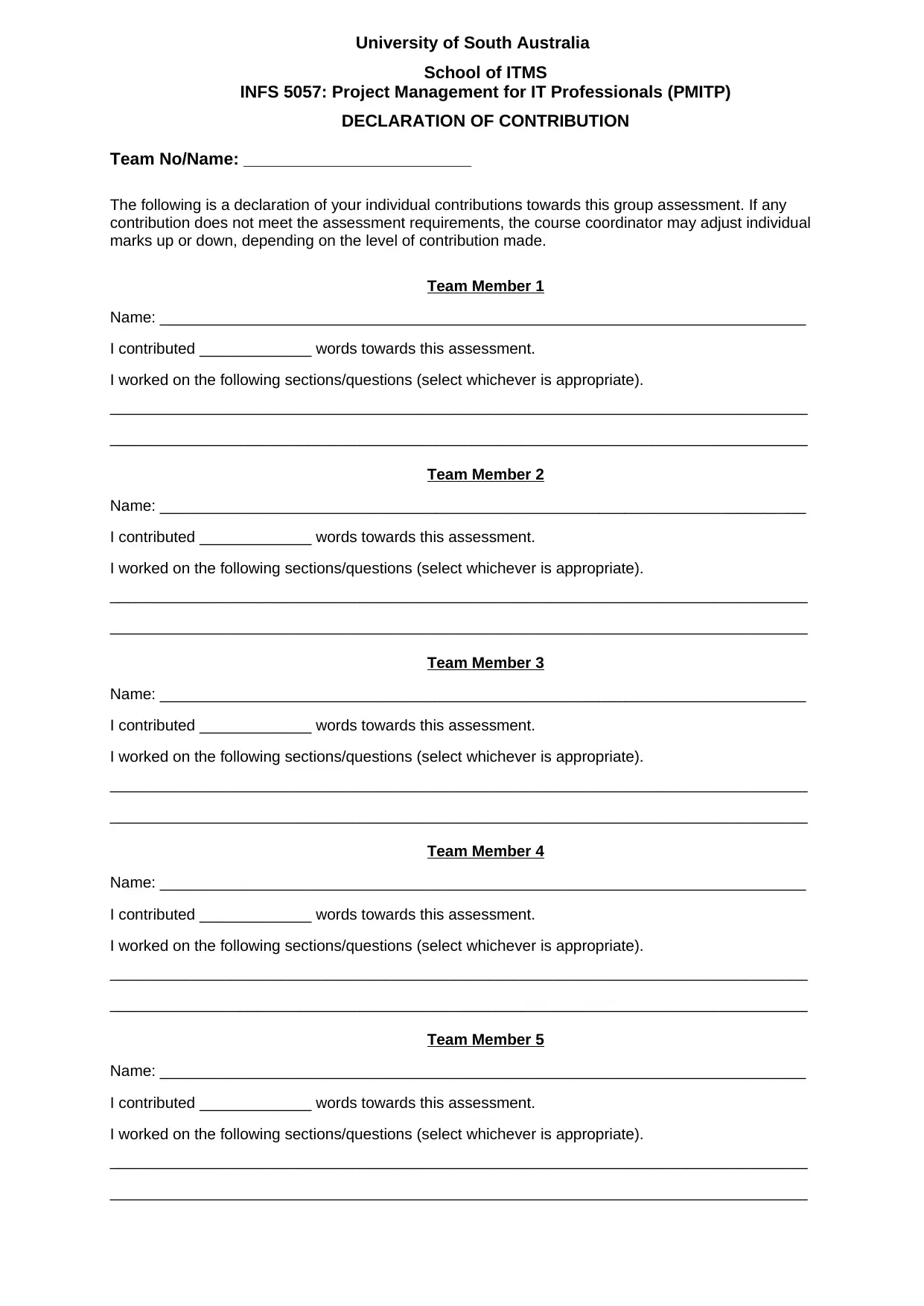
University of South Australia
School of ITMS
INFS 5057: Project Management for IT Professionals (PMITP)
DECLARATION OF CONTRIBUTION
Team No/Name: ________________________
The following is a declaration of your individual contributions towards this group assessment. If any
contribution does not meet the assessment requirements, the course coordinator may adjust individual
marks up or down, depending on the level of contribution made.
Team Member 1
Name: ___________________________________________________________________________
I contributed _____________ words towards this assessment.
I worked on the following sections/questions (select whichever is appropriate).
_________________________________________________________________________________
_________________________________________________________________________________
Team Member 2
Name: ___________________________________________________________________________
I contributed _____________ words towards this assessment.
I worked on the following sections/questions (select whichever is appropriate).
_________________________________________________________________________________
_________________________________________________________________________________
Team Member 3
Name: ___________________________________________________________________________
I contributed _____________ words towards this assessment.
I worked on the following sections/questions (select whichever is appropriate).
_________________________________________________________________________________
_________________________________________________________________________________
Team Member 4
Name: ___________________________________________________________________________
I contributed _____________ words towards this assessment.
I worked on the following sections/questions (select whichever is appropriate).
_________________________________________________________________________________
_________________________________________________________________________________
Team Member 5
Name: ___________________________________________________________________________
I contributed _____________ words towards this assessment.
I worked on the following sections/questions (select whichever is appropriate).
_________________________________________________________________________________
_________________________________________________________________________________
School of ITMS
INFS 5057: Project Management for IT Professionals (PMITP)
DECLARATION OF CONTRIBUTION
Team No/Name: ________________________
The following is a declaration of your individual contributions towards this group assessment. If any
contribution does not meet the assessment requirements, the course coordinator may adjust individual
marks up or down, depending on the level of contribution made.
Team Member 1
Name: ___________________________________________________________________________
I contributed _____________ words towards this assessment.
I worked on the following sections/questions (select whichever is appropriate).
_________________________________________________________________________________
_________________________________________________________________________________
Team Member 2
Name: ___________________________________________________________________________
I contributed _____________ words towards this assessment.
I worked on the following sections/questions (select whichever is appropriate).
_________________________________________________________________________________
_________________________________________________________________________________
Team Member 3
Name: ___________________________________________________________________________
I contributed _____________ words towards this assessment.
I worked on the following sections/questions (select whichever is appropriate).
_________________________________________________________________________________
_________________________________________________________________________________
Team Member 4
Name: ___________________________________________________________________________
I contributed _____________ words towards this assessment.
I worked on the following sections/questions (select whichever is appropriate).
_________________________________________________________________________________
_________________________________________________________________________________
Team Member 5
Name: ___________________________________________________________________________
I contributed _____________ words towards this assessment.
I worked on the following sections/questions (select whichever is appropriate).
_________________________________________________________________________________
_________________________________________________________________________________
Secure Best Marks with AI Grader
Need help grading? Try our AI Grader for instant feedback on your assignments.
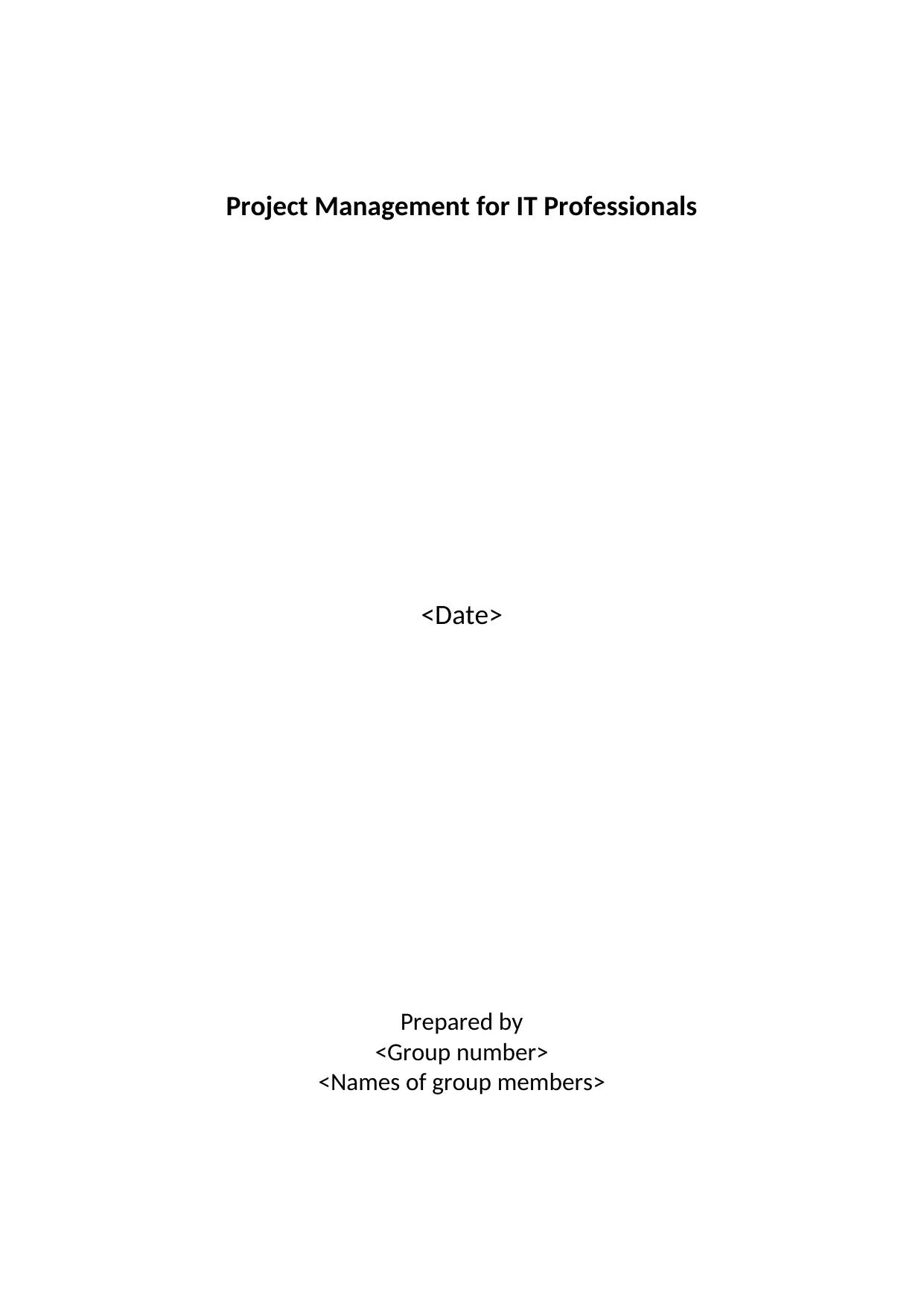
Project Management for IT Professionals
<Date>
Prepared by
<Group number>
<Names of group members>
<Date>
Prepared by
<Group number>
<Names of group members>
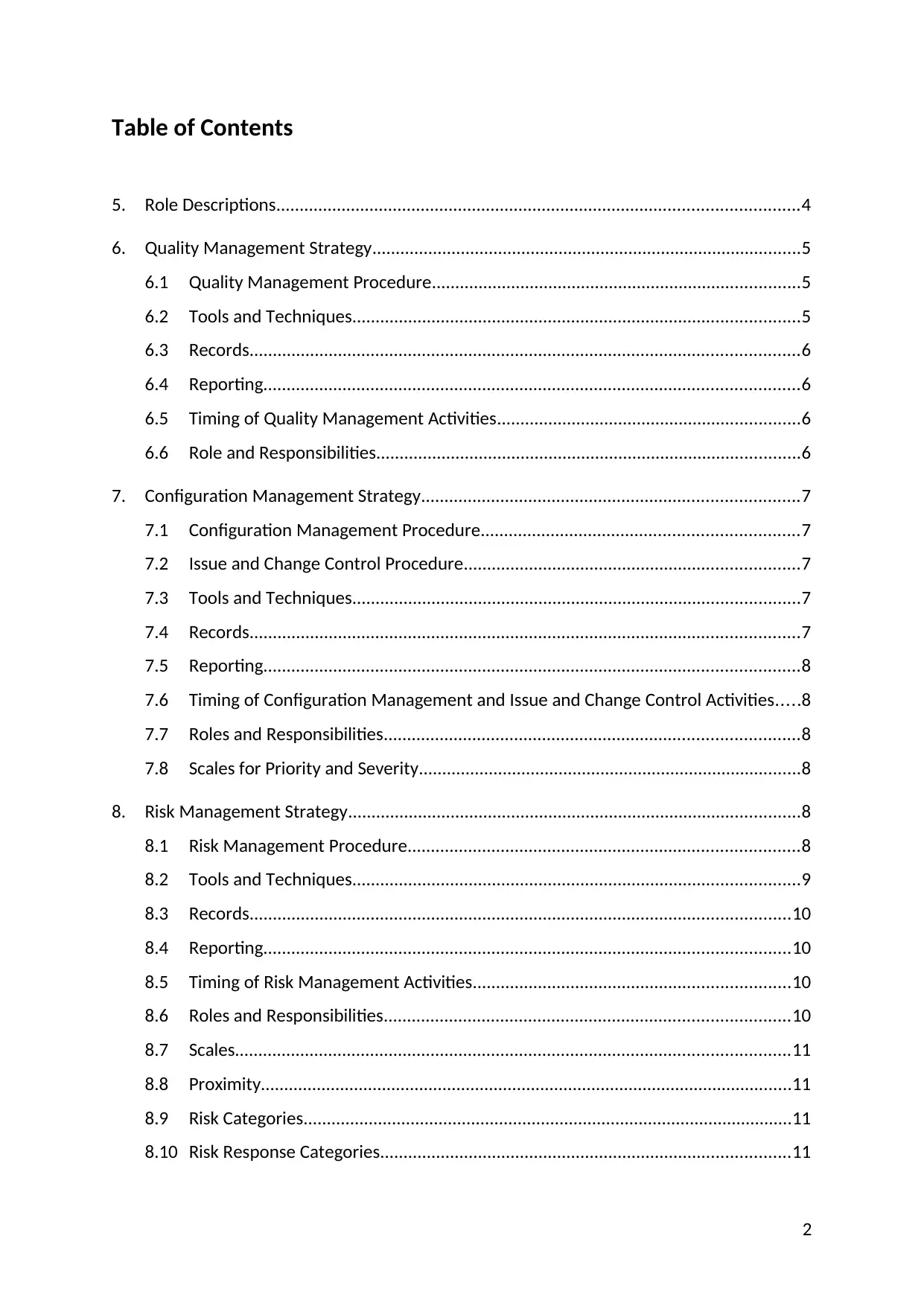
Table of Contents
5. Role Descriptions................................................................................................................4
6. Quality Management Strategy............................................................................................5
6.1 Quality Management Procedure...............................................................................5
6.2 Tools and Techniques................................................................................................5
6.3 Records......................................................................................................................6
6.4 Reporting...................................................................................................................6
6.5 Timing of Quality Management Activities.................................................................6
6.6 Role and Responsibilities...........................................................................................6
7. Configuration Management Strategy.................................................................................7
7.1 Configuration Management Procedure....................................................................7
7.2 Issue and Change Control Procedure........................................................................7
7.3 Tools and Techniques................................................................................................7
7.4 Records......................................................................................................................7
7.5 Reporting...................................................................................................................8
7.6 Timing of Configuration Management and Issue and Change Control Activities.....8
7.7 Roles and Responsibilities.........................................................................................8
7.8 Scales for Priority and Severity..................................................................................8
8. Risk Management Strategy.................................................................................................8
8.1 Risk Management Procedure....................................................................................8
8.2 Tools and Techniques................................................................................................9
8.3 Records....................................................................................................................10
8.4 Reporting.................................................................................................................10
8.5 Timing of Risk Management Activities....................................................................10
8.6 Roles and Responsibilities.......................................................................................10
8.7 Scales.......................................................................................................................11
8.8 Proximity..................................................................................................................11
8.9 Risk Categories.........................................................................................................11
8.10 Risk Response Categories........................................................................................11
2
5. Role Descriptions................................................................................................................4
6. Quality Management Strategy............................................................................................5
6.1 Quality Management Procedure...............................................................................5
6.2 Tools and Techniques................................................................................................5
6.3 Records......................................................................................................................6
6.4 Reporting...................................................................................................................6
6.5 Timing of Quality Management Activities.................................................................6
6.6 Role and Responsibilities...........................................................................................6
7. Configuration Management Strategy.................................................................................7
7.1 Configuration Management Procedure....................................................................7
7.2 Issue and Change Control Procedure........................................................................7
7.3 Tools and Techniques................................................................................................7
7.4 Records......................................................................................................................7
7.5 Reporting...................................................................................................................8
7.6 Timing of Configuration Management and Issue and Change Control Activities.....8
7.7 Roles and Responsibilities.........................................................................................8
7.8 Scales for Priority and Severity..................................................................................8
8. Risk Management Strategy.................................................................................................8
8.1 Risk Management Procedure....................................................................................8
8.2 Tools and Techniques................................................................................................9
8.3 Records....................................................................................................................10
8.4 Reporting.................................................................................................................10
8.5 Timing of Risk Management Activities....................................................................10
8.6 Roles and Responsibilities.......................................................................................10
8.7 Scales.......................................................................................................................11
8.8 Proximity..................................................................................................................11
8.9 Risk Categories.........................................................................................................11
8.10 Risk Response Categories........................................................................................11
2
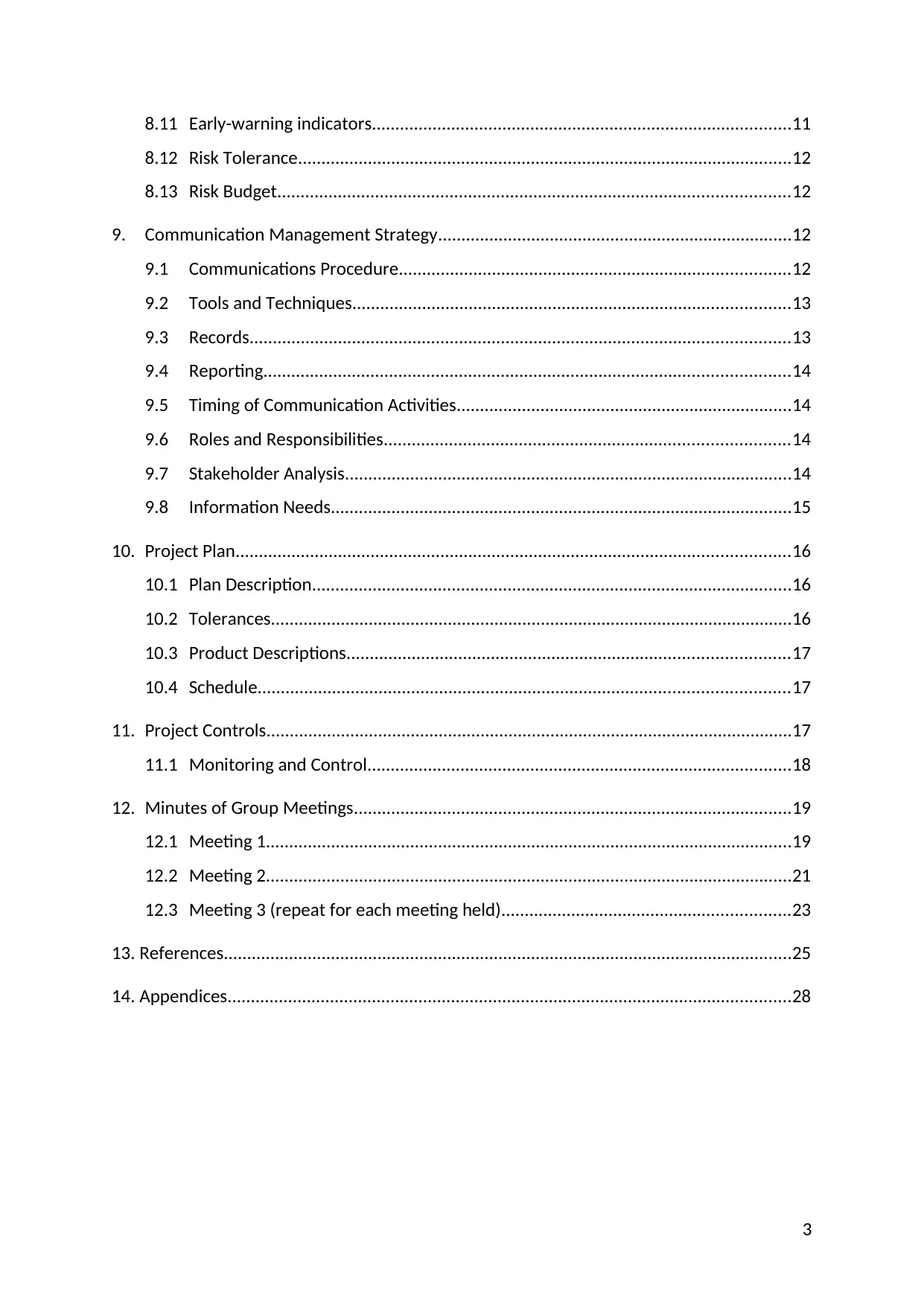
8.11 Early-warning indicators..........................................................................................11
8.12 Risk Tolerance..........................................................................................................12
8.13 Risk Budget..............................................................................................................12
9. Communication Management Strategy............................................................................12
9.1 Communications Procedure....................................................................................12
9.2 Tools and Techniques..............................................................................................13
9.3 Records....................................................................................................................13
9.4 Reporting.................................................................................................................14
9.5 Timing of Communication Activities........................................................................14
9.6 Roles and Responsibilities.......................................................................................14
9.7 Stakeholder Analysis................................................................................................14
9.8 Information Needs...................................................................................................15
10. Project Plan.......................................................................................................................16
10.1 Plan Description.......................................................................................................16
10.2 Tolerances................................................................................................................16
10.3 Product Descriptions...............................................................................................17
10.4 Schedule..................................................................................................................17
11. Project Controls.................................................................................................................17
11.1 Monitoring and Control...........................................................................................18
12. Minutes of Group Meetings..............................................................................................19
12.1 Meeting 1.................................................................................................................19
12.2 Meeting 2.................................................................................................................21
12.3 Meeting 3 (repeat for each meeting held)..............................................................23
13. References..........................................................................................................................25
14. Appendices.........................................................................................................................28
3
8.12 Risk Tolerance..........................................................................................................12
8.13 Risk Budget..............................................................................................................12
9. Communication Management Strategy............................................................................12
9.1 Communications Procedure....................................................................................12
9.2 Tools and Techniques..............................................................................................13
9.3 Records....................................................................................................................13
9.4 Reporting.................................................................................................................14
9.5 Timing of Communication Activities........................................................................14
9.6 Roles and Responsibilities.......................................................................................14
9.7 Stakeholder Analysis................................................................................................14
9.8 Information Needs...................................................................................................15
10. Project Plan.......................................................................................................................16
10.1 Plan Description.......................................................................................................16
10.2 Tolerances................................................................................................................16
10.3 Product Descriptions...............................................................................................17
10.4 Schedule..................................................................................................................17
11. Project Controls.................................................................................................................17
11.1 Monitoring and Control...........................................................................................18
12. Minutes of Group Meetings..............................................................................................19
12.1 Meeting 1.................................................................................................................19
12.2 Meeting 2.................................................................................................................21
12.3 Meeting 3 (repeat for each meeting held)..............................................................23
13. References..........................................................................................................................25
14. Appendices.........................................................................................................................28
3
Secure Best Marks with AI Grader
Need help grading? Try our AI Grader for instant feedback on your assignments.
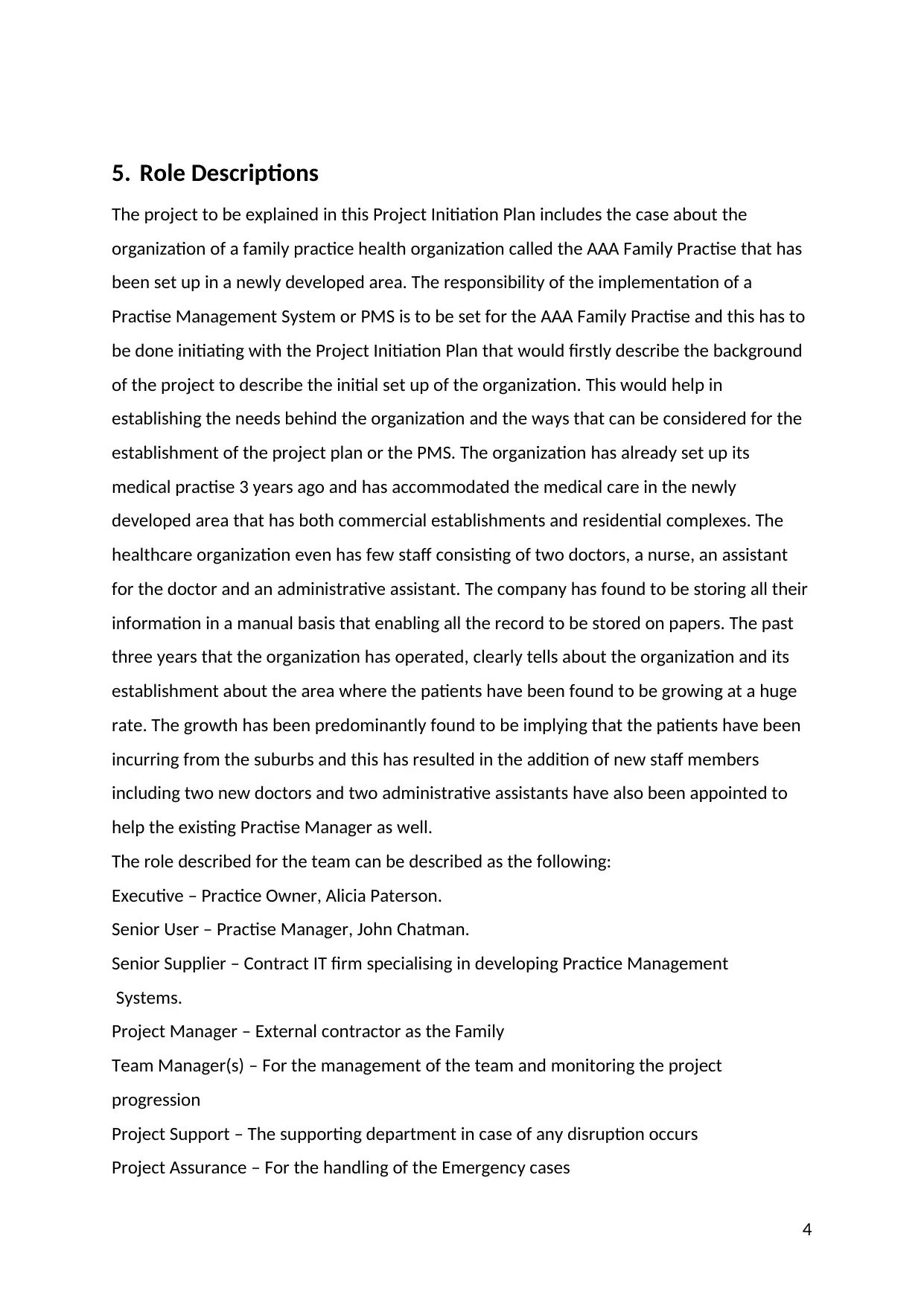
5. Role Descriptions
The project to be explained in this Project Initiation Plan includes the case about the
organization of a family practice health organization called the AAA Family Practise that has
been set up in a newly developed area. The responsibility of the implementation of a
Practise Management System or PMS is to be set for the AAA Family Practise and this has to
be done initiating with the Project Initiation Plan that would firstly describe the background
of the project to describe the initial set up of the organization. This would help in
establishing the needs behind the organization and the ways that can be considered for the
establishment of the project plan or the PMS. The organization has already set up its
medical practise 3 years ago and has accommodated the medical care in the newly
developed area that has both commercial establishments and residential complexes. The
healthcare organization even has few staff consisting of two doctors, a nurse, an assistant
for the doctor and an administrative assistant. The company has found to be storing all their
information in a manual basis that enabling all the record to be stored on papers. The past
three years that the organization has operated, clearly tells about the organization and its
establishment about the area where the patients have been found to be growing at a huge
rate. The growth has been predominantly found to be implying that the patients have been
incurring from the suburbs and this has resulted in the addition of new staff members
including two new doctors and two administrative assistants have also been appointed to
help the existing Practise Manager as well.
The role described for the team can be described as the following:
Executive – Practice Owner, Alicia Paterson.
Senior User – Practise Manager, John Chatman.
Senior Supplier – Contract IT firm specialising in developing Practice Management
Systems.
Project Manager – External contractor as the Family
Team Manager(s) – For the management of the team and monitoring the project
progression
Project Support – The supporting department in case of any disruption occurs
Project Assurance – For the handling of the Emergency cases
4
The project to be explained in this Project Initiation Plan includes the case about the
organization of a family practice health organization called the AAA Family Practise that has
been set up in a newly developed area. The responsibility of the implementation of a
Practise Management System or PMS is to be set for the AAA Family Practise and this has to
be done initiating with the Project Initiation Plan that would firstly describe the background
of the project to describe the initial set up of the organization. This would help in
establishing the needs behind the organization and the ways that can be considered for the
establishment of the project plan or the PMS. The organization has already set up its
medical practise 3 years ago and has accommodated the medical care in the newly
developed area that has both commercial establishments and residential complexes. The
healthcare organization even has few staff consisting of two doctors, a nurse, an assistant
for the doctor and an administrative assistant. The company has found to be storing all their
information in a manual basis that enabling all the record to be stored on papers. The past
three years that the organization has operated, clearly tells about the organization and its
establishment about the area where the patients have been found to be growing at a huge
rate. The growth has been predominantly found to be implying that the patients have been
incurring from the suburbs and this has resulted in the addition of new staff members
including two new doctors and two administrative assistants have also been appointed to
help the existing Practise Manager as well.
The role described for the team can be described as the following:
Executive – Practice Owner, Alicia Paterson.
Senior User – Practise Manager, John Chatman.
Senior Supplier – Contract IT firm specialising in developing Practice Management
Systems.
Project Manager – External contractor as the Family
Team Manager(s) – For the management of the team and monitoring the project
progression
Project Support – The supporting department in case of any disruption occurs
Project Assurance – For the handling of the Emergency cases
4
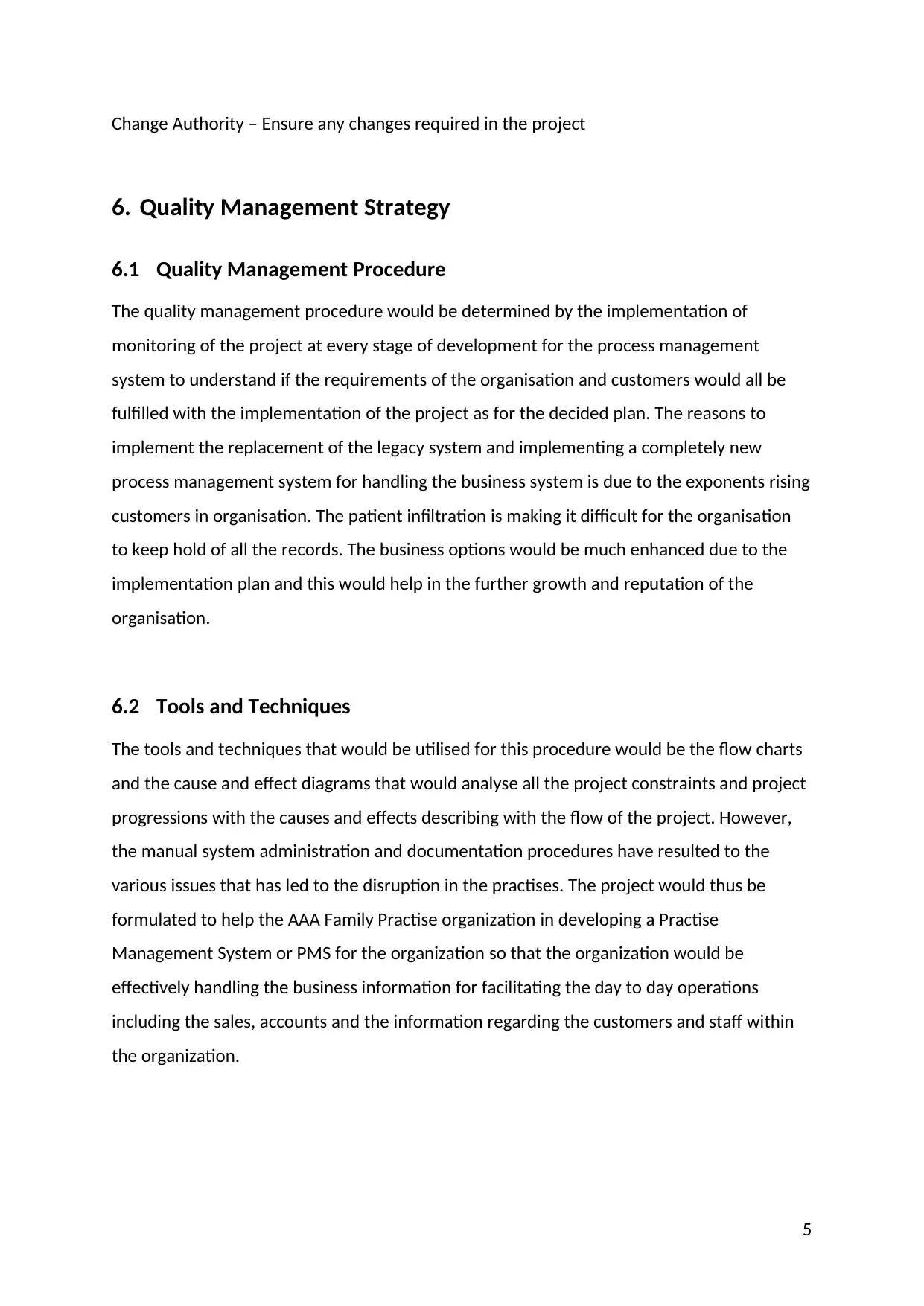
Change Authority – Ensure any changes required in the project
6. Quality Management Strategy
6.1 Quality Management Procedure
The quality management procedure would be determined by the implementation of
monitoring of the project at every stage of development for the process management
system to understand if the requirements of the organisation and customers would all be
fulfilled with the implementation of the project as for the decided plan. The reasons to
implement the replacement of the legacy system and implementing a completely new
process management system for handling the business system is due to the exponents rising
customers in organisation. The patient infiltration is making it difficult for the organisation
to keep hold of all the records. The business options would be much enhanced due to the
implementation plan and this would help in the further growth and reputation of the
organisation.
6.2 Tools and Techniques
The tools and techniques that would be utilised for this procedure would be the flow charts
and the cause and effect diagrams that would analyse all the project constraints and project
progressions with the causes and effects describing with the flow of the project. However,
the manual system administration and documentation procedures have resulted to the
various issues that has led to the disruption in the practises. The project would thus be
formulated to help the AAA Family Practise organization in developing a Practise
Management System or PMS for the organization so that the organization would be
effectively handling the business information for facilitating the day to day operations
including the sales, accounts and the information regarding the customers and staff within
the organization.
5
6. Quality Management Strategy
6.1 Quality Management Procedure
The quality management procedure would be determined by the implementation of
monitoring of the project at every stage of development for the process management
system to understand if the requirements of the organisation and customers would all be
fulfilled with the implementation of the project as for the decided plan. The reasons to
implement the replacement of the legacy system and implementing a completely new
process management system for handling the business system is due to the exponents rising
customers in organisation. The patient infiltration is making it difficult for the organisation
to keep hold of all the records. The business options would be much enhanced due to the
implementation plan and this would help in the further growth and reputation of the
organisation.
6.2 Tools and Techniques
The tools and techniques that would be utilised for this procedure would be the flow charts
and the cause and effect diagrams that would analyse all the project constraints and project
progressions with the causes and effects describing with the flow of the project. However,
the manual system administration and documentation procedures have resulted to the
various issues that has led to the disruption in the practises. The project would thus be
formulated to help the AAA Family Practise organization in developing a Practise
Management System or PMS for the organization so that the organization would be
effectively handling the business information for facilitating the day to day operations
including the sales, accounts and the information regarding the customers and staff within
the organization.
5
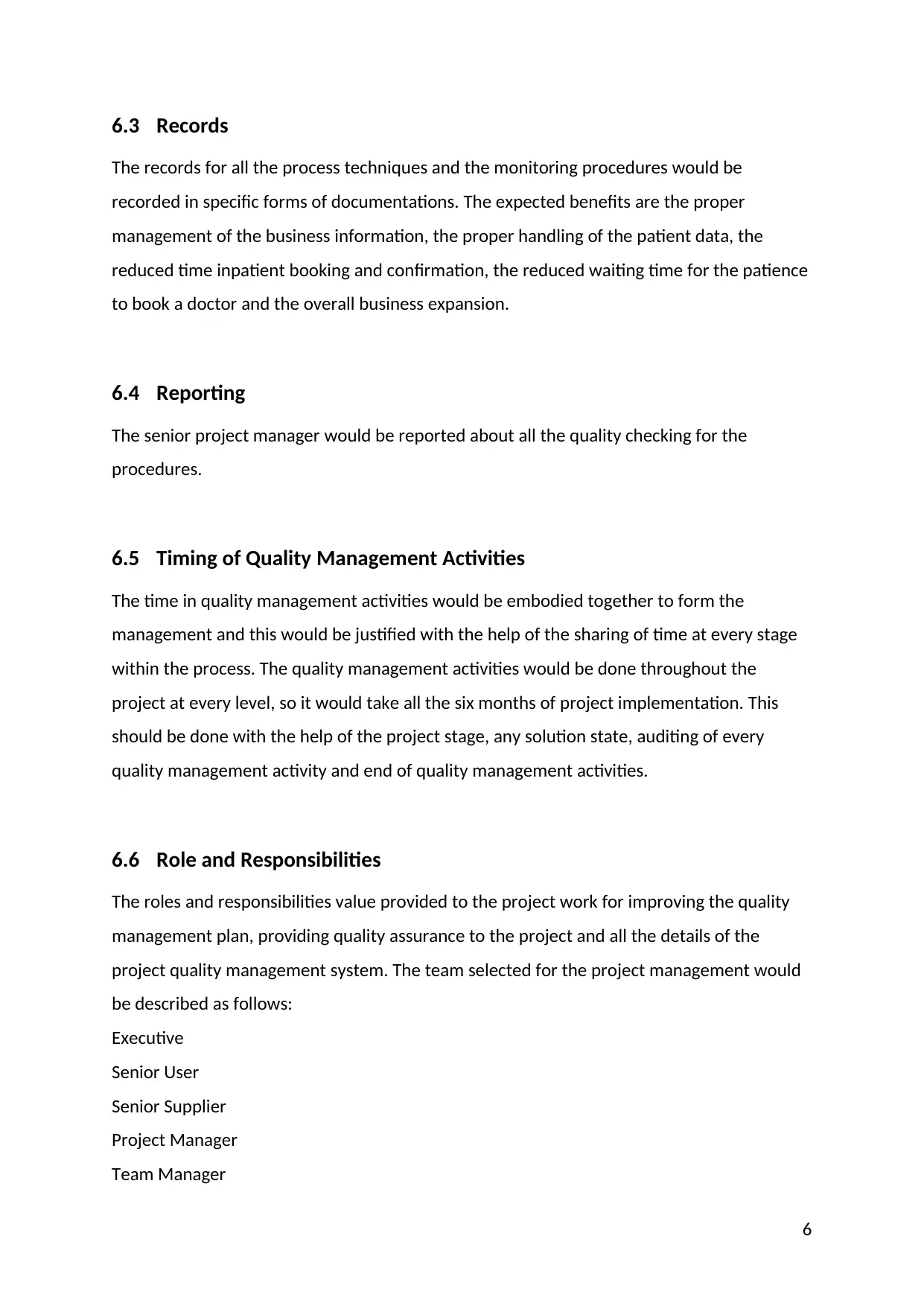
6.3 Records
The records for all the process techniques and the monitoring procedures would be
recorded in specific forms of documentations. The expected benefits are the proper
management of the business information, the proper handling of the patient data, the
reduced time inpatient booking and confirmation, the reduced waiting time for the patience
to book a doctor and the overall business expansion.
6.4 Reporting
The senior project manager would be reported about all the quality checking for the
procedures.
6.5 Timing of Quality Management Activities
The time in quality management activities would be embodied together to form the
management and this would be justified with the help of the sharing of time at every stage
within the process. The quality management activities would be done throughout the
project at every level, so it would take all the six months of project implementation. This
should be done with the help of the project stage, any solution state, auditing of every
quality management activity and end of quality management activities.
6.6 Role and Responsibilities
The roles and responsibilities value provided to the project work for improving the quality
management plan, providing quality assurance to the project and all the details of the
project quality management system. The team selected for the project management would
be described as follows:
Executive
Senior User
Senior Supplier
Project Manager
Team Manager
6
The records for all the process techniques and the monitoring procedures would be
recorded in specific forms of documentations. The expected benefits are the proper
management of the business information, the proper handling of the patient data, the
reduced time inpatient booking and confirmation, the reduced waiting time for the patience
to book a doctor and the overall business expansion.
6.4 Reporting
The senior project manager would be reported about all the quality checking for the
procedures.
6.5 Timing of Quality Management Activities
The time in quality management activities would be embodied together to form the
management and this would be justified with the help of the sharing of time at every stage
within the process. The quality management activities would be done throughout the
project at every level, so it would take all the six months of project implementation. This
should be done with the help of the project stage, any solution state, auditing of every
quality management activity and end of quality management activities.
6.6 Role and Responsibilities
The roles and responsibilities value provided to the project work for improving the quality
management plan, providing quality assurance to the project and all the details of the
project quality management system. The team selected for the project management would
be described as follows:
Executive
Senior User
Senior Supplier
Project Manager
Team Manager
6
Paraphrase This Document
Need a fresh take? Get an instant paraphrase of this document with our AI Paraphraser
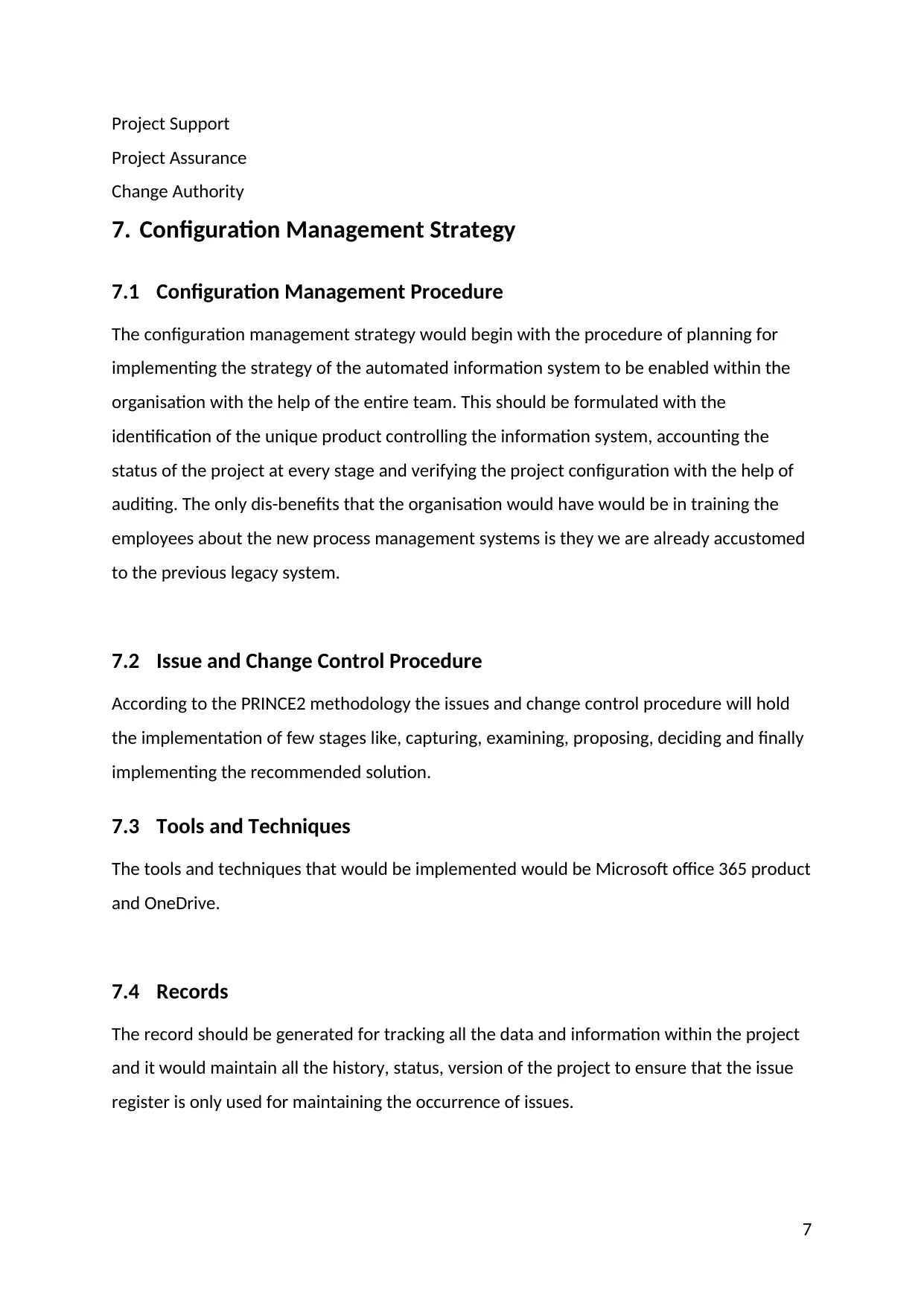
Project Support
Project Assurance
Change Authority
7. Configuration Management Strategy
7.1 Configuration Management Procedure
The configuration management strategy would begin with the procedure of planning for
implementing the strategy of the automated information system to be enabled within the
organisation with the help of the entire team. This should be formulated with the
identification of the unique product controlling the information system, accounting the
status of the project at every stage and verifying the project configuration with the help of
auditing. The only dis-benefits that the organisation would have would be in training the
employees about the new process management systems is they we are already accustomed
to the previous legacy system.
7.2 Issue and Change Control Procedure
According to the PRINCE2 methodology the issues and change control procedure will hold
the implementation of few stages like, capturing, examining, proposing, deciding and finally
implementing the recommended solution.
7.3 Tools and Techniques
The tools and techniques that would be implemented would be Microsoft office 365 product
and OneDrive.
7.4 Records
The record should be generated for tracking all the data and information within the project
and it would maintain all the history, status, version of the project to ensure that the issue
register is only used for maintaining the occurrence of issues.
7
Project Assurance
Change Authority
7. Configuration Management Strategy
7.1 Configuration Management Procedure
The configuration management strategy would begin with the procedure of planning for
implementing the strategy of the automated information system to be enabled within the
organisation with the help of the entire team. This should be formulated with the
identification of the unique product controlling the information system, accounting the
status of the project at every stage and verifying the project configuration with the help of
auditing. The only dis-benefits that the organisation would have would be in training the
employees about the new process management systems is they we are already accustomed
to the previous legacy system.
7.2 Issue and Change Control Procedure
According to the PRINCE2 methodology the issues and change control procedure will hold
the implementation of few stages like, capturing, examining, proposing, deciding and finally
implementing the recommended solution.
7.3 Tools and Techniques
The tools and techniques that would be implemented would be Microsoft office 365 product
and OneDrive.
7.4 Records
The record should be generated for tracking all the data and information within the project
and it would maintain all the history, status, version of the project to ensure that the issue
register is only used for maintaining the occurrence of issues.
7
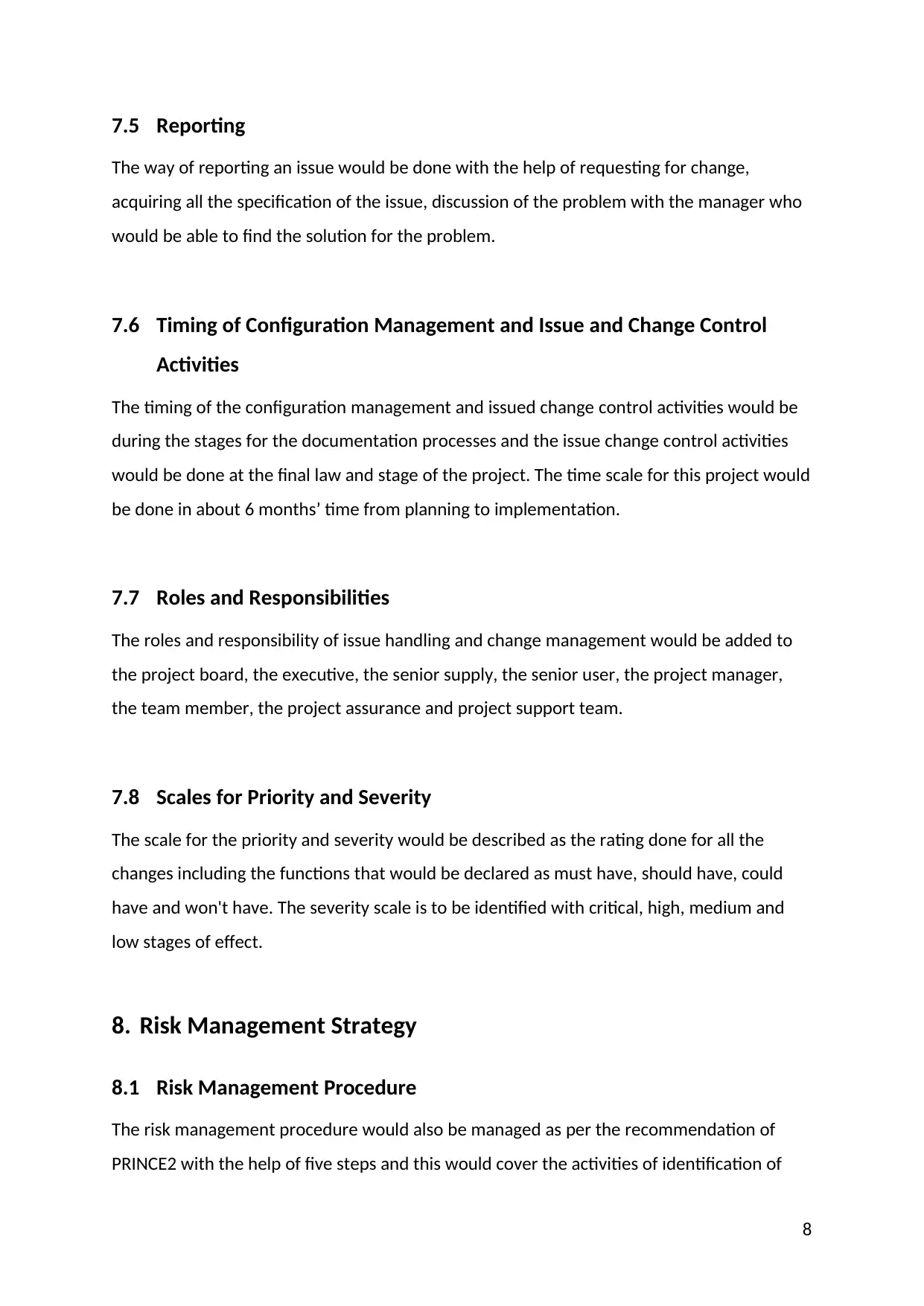
7.5 Reporting
The way of reporting an issue would be done with the help of requesting for change,
acquiring all the specification of the issue, discussion of the problem with the manager who
would be able to find the solution for the problem.
7.6 Timing of Configuration Management and Issue and Change Control
Activities
The timing of the configuration management and issued change control activities would be
during the stages for the documentation processes and the issue change control activities
would be done at the final law and stage of the project. The time scale for this project would
be done in about 6 months’ time from planning to implementation.
7.7 Roles and Responsibilities
The roles and responsibility of issue handling and change management would be added to
the project board, the executive, the senior supply, the senior user, the project manager,
the team member, the project assurance and project support team.
7.8 Scales for Priority and Severity
The scale for the priority and severity would be described as the rating done for all the
changes including the functions that would be declared as must have, should have, could
have and won't have. The severity scale is to be identified with critical, high, medium and
low stages of effect.
8. Risk Management Strategy
8.1 Risk Management Procedure
The risk management procedure would also be managed as per the recommendation of
PRINCE2 with the help of five steps and this would cover the activities of identification of
8
The way of reporting an issue would be done with the help of requesting for change,
acquiring all the specification of the issue, discussion of the problem with the manager who
would be able to find the solution for the problem.
7.6 Timing of Configuration Management and Issue and Change Control
Activities
The timing of the configuration management and issued change control activities would be
during the stages for the documentation processes and the issue change control activities
would be done at the final law and stage of the project. The time scale for this project would
be done in about 6 months’ time from planning to implementation.
7.7 Roles and Responsibilities
The roles and responsibility of issue handling and change management would be added to
the project board, the executive, the senior supply, the senior user, the project manager,
the team member, the project assurance and project support team.
7.8 Scales for Priority and Severity
The scale for the priority and severity would be described as the rating done for all the
changes including the functions that would be declared as must have, should have, could
have and won't have. The severity scale is to be identified with critical, high, medium and
low stages of effect.
8. Risk Management Strategy
8.1 Risk Management Procedure
The risk management procedure would also be managed as per the recommendation of
PRINCE2 with the help of five steps and this would cover the activities of identification of
8
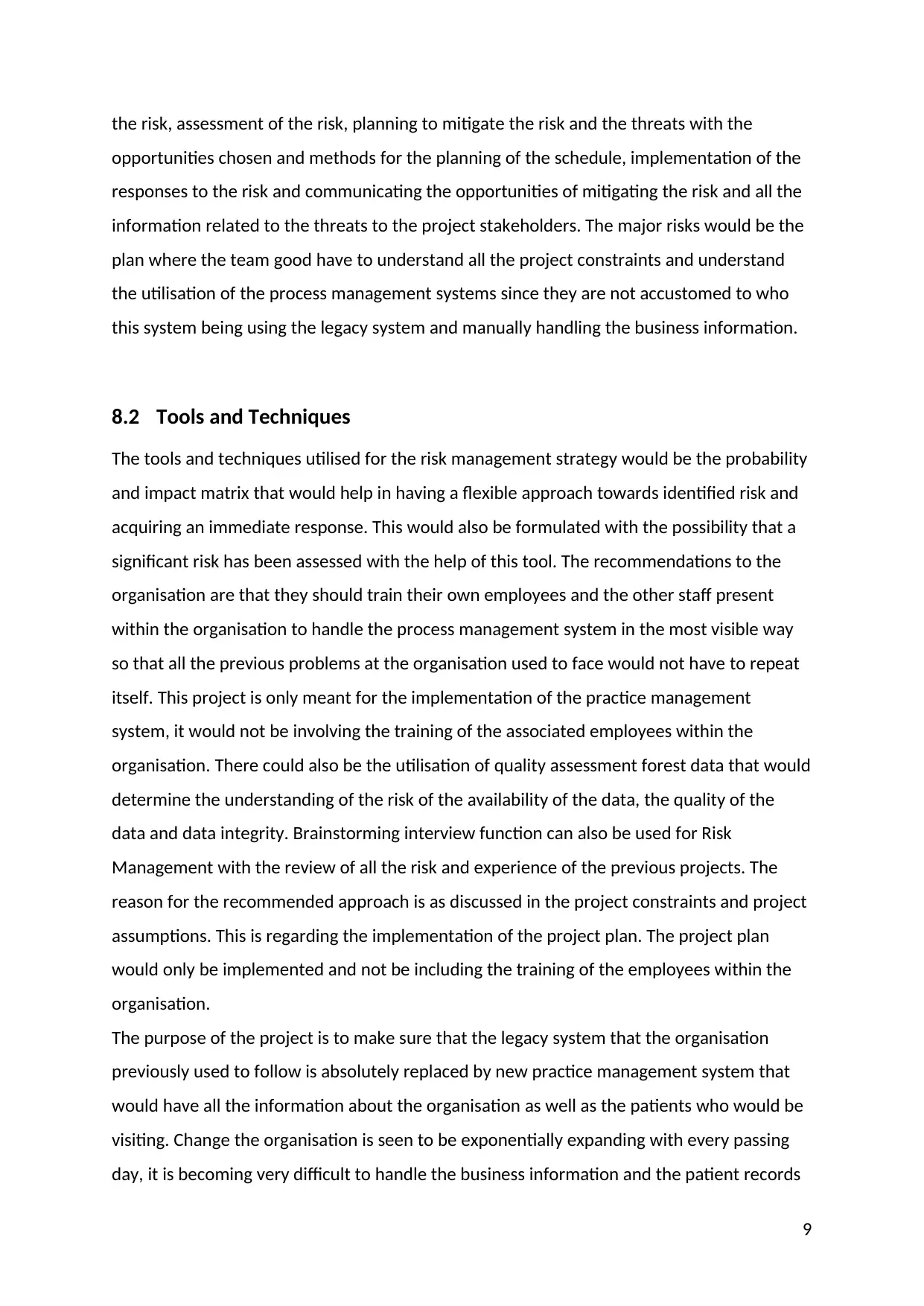
the risk, assessment of the risk, planning to mitigate the risk and the threats with the
opportunities chosen and methods for the planning of the schedule, implementation of the
responses to the risk and communicating the opportunities of mitigating the risk and all the
information related to the threats to the project stakeholders. The major risks would be the
plan where the team good have to understand all the project constraints and understand
the utilisation of the process management systems since they are not accustomed to who
this system being using the legacy system and manually handling the business information.
8.2 Tools and Techniques
The tools and techniques utilised for the risk management strategy would be the probability
and impact matrix that would help in having a flexible approach towards identified risk and
acquiring an immediate response. This would also be formulated with the possibility that a
significant risk has been assessed with the help of this tool. The recommendations to the
organisation are that they should train their own employees and the other staff present
within the organisation to handle the process management system in the most visible way
so that all the previous problems at the organisation used to face would not have to repeat
itself. This project is only meant for the implementation of the practice management
system, it would not be involving the training of the associated employees within the
organisation. There could also be the utilisation of quality assessment forest data that would
determine the understanding of the risk of the availability of the data, the quality of the
data and data integrity. Brainstorming interview function can also be used for Risk
Management with the review of all the risk and experience of the previous projects. The
reason for the recommended approach is as discussed in the project constraints and project
assumptions. This is regarding the implementation of the project plan. The project plan
would only be implemented and not be including the training of the employees within the
organisation.
The purpose of the project is to make sure that the legacy system that the organisation
previously used to follow is absolutely replaced by new practice management system that
would have all the information about the organisation as well as the patients who would be
visiting. Change the organisation is seen to be exponentially expanding with every passing
day, it is becoming very difficult to handle the business information and the patient records
9
opportunities chosen and methods for the planning of the schedule, implementation of the
responses to the risk and communicating the opportunities of mitigating the risk and all the
information related to the threats to the project stakeholders. The major risks would be the
plan where the team good have to understand all the project constraints and understand
the utilisation of the process management systems since they are not accustomed to who
this system being using the legacy system and manually handling the business information.
8.2 Tools and Techniques
The tools and techniques utilised for the risk management strategy would be the probability
and impact matrix that would help in having a flexible approach towards identified risk and
acquiring an immediate response. This would also be formulated with the possibility that a
significant risk has been assessed with the help of this tool. The recommendations to the
organisation are that they should train their own employees and the other staff present
within the organisation to handle the process management system in the most visible way
so that all the previous problems at the organisation used to face would not have to repeat
itself. This project is only meant for the implementation of the practice management
system, it would not be involving the training of the associated employees within the
organisation. There could also be the utilisation of quality assessment forest data that would
determine the understanding of the risk of the availability of the data, the quality of the
data and data integrity. Brainstorming interview function can also be used for Risk
Management with the review of all the risk and experience of the previous projects. The
reason for the recommended approach is as discussed in the project constraints and project
assumptions. This is regarding the implementation of the project plan. The project plan
would only be implemented and not be including the training of the employees within the
organisation.
The purpose of the project is to make sure that the legacy system that the organisation
previously used to follow is absolutely replaced by new practice management system that
would have all the information about the organisation as well as the patients who would be
visiting. Change the organisation is seen to be exponentially expanding with every passing
day, it is becoming very difficult to handle the business information and the patient records
9
Secure Best Marks with AI Grader
Need help grading? Try our AI Grader for instant feedback on your assignments.
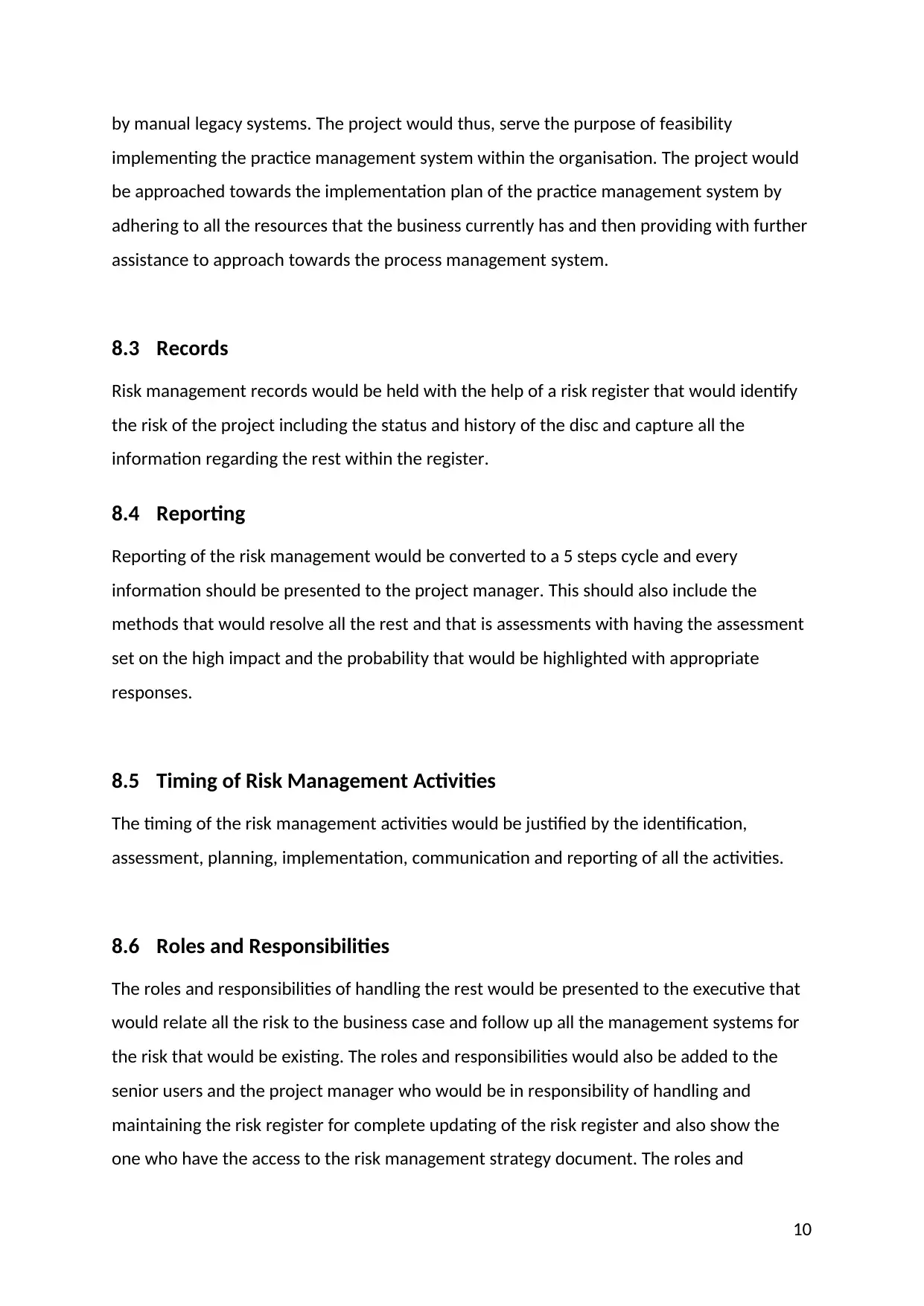
by manual legacy systems. The project would thus, serve the purpose of feasibility
implementing the practice management system within the organisation. The project would
be approached towards the implementation plan of the practice management system by
adhering to all the resources that the business currently has and then providing with further
assistance to approach towards the process management system.
8.3 Records
Risk management records would be held with the help of a risk register that would identify
the risk of the project including the status and history of the disc and capture all the
information regarding the rest within the register.
8.4 Reporting
Reporting of the risk management would be converted to a 5 steps cycle and every
information should be presented to the project manager. This should also include the
methods that would resolve all the rest and that is assessments with having the assessment
set on the high impact and the probability that would be highlighted with appropriate
responses.
8.5 Timing of Risk Management Activities
The timing of the risk management activities would be justified by the identification,
assessment, planning, implementation, communication and reporting of all the activities.
8.6 Roles and Responsibilities
The roles and responsibilities of handling the rest would be presented to the executive that
would relate all the risk to the business case and follow up all the management systems for
the risk that would be existing. The roles and responsibilities would also be added to the
senior users and the project manager who would be in responsibility of handling and
maintaining the risk register for complete updating of the risk register and also show the
one who have the access to the risk management strategy document. The roles and
10
implementing the practice management system within the organisation. The project would
be approached towards the implementation plan of the practice management system by
adhering to all the resources that the business currently has and then providing with further
assistance to approach towards the process management system.
8.3 Records
Risk management records would be held with the help of a risk register that would identify
the risk of the project including the status and history of the disc and capture all the
information regarding the rest within the register.
8.4 Reporting
Reporting of the risk management would be converted to a 5 steps cycle and every
information should be presented to the project manager. This should also include the
methods that would resolve all the rest and that is assessments with having the assessment
set on the high impact and the probability that would be highlighted with appropriate
responses.
8.5 Timing of Risk Management Activities
The timing of the risk management activities would be justified by the identification,
assessment, planning, implementation, communication and reporting of all the activities.
8.6 Roles and Responsibilities
The roles and responsibilities of handling the rest would be presented to the executive that
would relate all the risk to the business case and follow up all the management systems for
the risk that would be existing. The roles and responsibilities would also be added to the
senior users and the project manager who would be in responsibility of handling and
maintaining the risk register for complete updating of the risk register and also show the
one who have the access to the risk management strategy document. The roles and
10
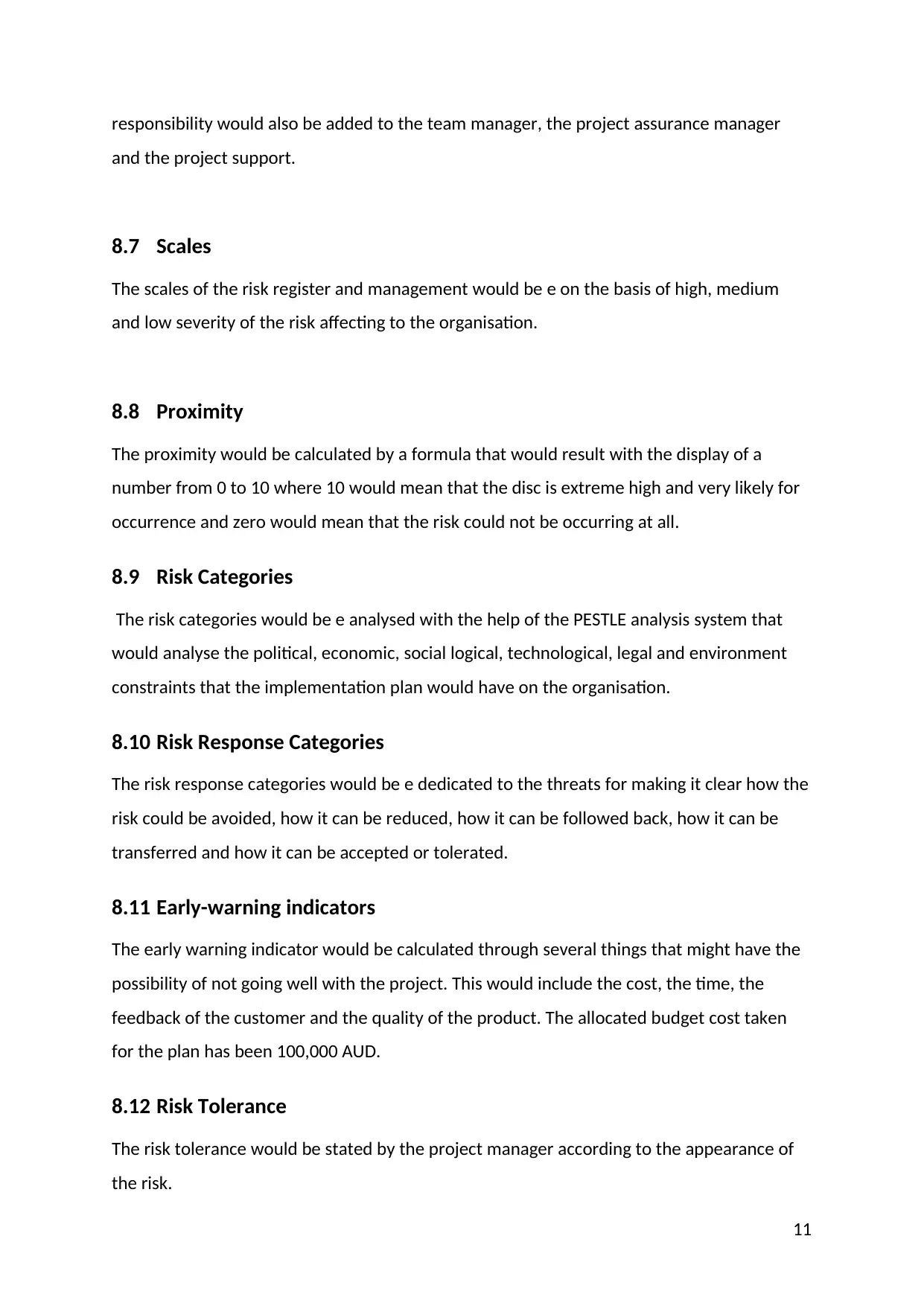
responsibility would also be added to the team manager, the project assurance manager
and the project support.
8.7 Scales
The scales of the risk register and management would be e on the basis of high, medium
and low severity of the risk affecting to the organisation.
8.8 Proximity
The proximity would be calculated by a formula that would result with the display of a
number from 0 to 10 where 10 would mean that the disc is extreme high and very likely for
occurrence and zero would mean that the risk could not be occurring at all.
8.9 Risk Categories
The risk categories would be e analysed with the help of the PESTLE analysis system that
would analyse the political, economic, social logical, technological, legal and environment
constraints that the implementation plan would have on the organisation.
8.10 Risk Response Categories
The risk response categories would be e dedicated to the threats for making it clear how the
risk could be avoided, how it can be reduced, how it can be followed back, how it can be
transferred and how it can be accepted or tolerated.
8.11 Early-warning indicators
The early warning indicator would be calculated through several things that might have the
possibility of not going well with the project. This would include the cost, the time, the
feedback of the customer and the quality of the product. The allocated budget cost taken
for the plan has been 100,000 AUD.
8.12 Risk Tolerance
The risk tolerance would be stated by the project manager according to the appearance of
the risk.
11
and the project support.
8.7 Scales
The scales of the risk register and management would be e on the basis of high, medium
and low severity of the risk affecting to the organisation.
8.8 Proximity
The proximity would be calculated by a formula that would result with the display of a
number from 0 to 10 where 10 would mean that the disc is extreme high and very likely for
occurrence and zero would mean that the risk could not be occurring at all.
8.9 Risk Categories
The risk categories would be e analysed with the help of the PESTLE analysis system that
would analyse the political, economic, social logical, technological, legal and environment
constraints that the implementation plan would have on the organisation.
8.10 Risk Response Categories
The risk response categories would be e dedicated to the threats for making it clear how the
risk could be avoided, how it can be reduced, how it can be followed back, how it can be
transferred and how it can be accepted or tolerated.
8.11 Early-warning indicators
The early warning indicator would be calculated through several things that might have the
possibility of not going well with the project. This would include the cost, the time, the
feedback of the customer and the quality of the product. The allocated budget cost taken
for the plan has been 100,000 AUD.
8.12 Risk Tolerance
The risk tolerance would be stated by the project manager according to the appearance of
the risk.
11
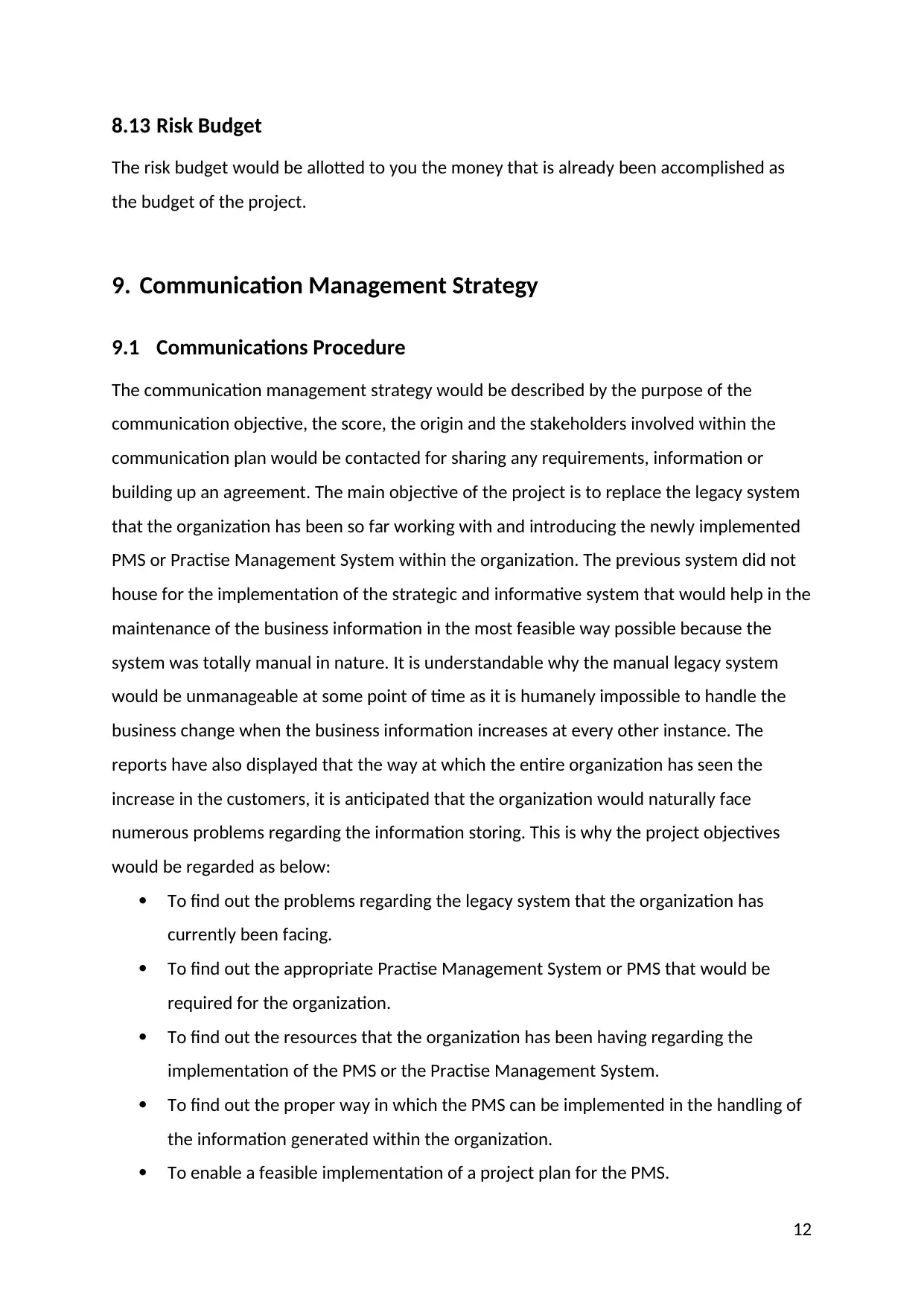
8.13 Risk Budget
The risk budget would be allotted to you the money that is already been accomplished as
the budget of the project.
9. Communication Management Strategy
9.1 Communications Procedure
The communication management strategy would be described by the purpose of the
communication objective, the score, the origin and the stakeholders involved within the
communication plan would be contacted for sharing any requirements, information or
building up an agreement. The main objective of the project is to replace the legacy system
that the organization has been so far working with and introducing the newly implemented
PMS or Practise Management System within the organization. The previous system did not
house for the implementation of the strategic and informative system that would help in the
maintenance of the business information in the most feasible way possible because the
system was totally manual in nature. It is understandable why the manual legacy system
would be unmanageable at some point of time as it is humanely impossible to handle the
business change when the business information increases at every other instance. The
reports have also displayed that the way at which the entire organization has seen the
increase in the customers, it is anticipated that the organization would naturally face
numerous problems regarding the information storing. This is why the project objectives
would be regarded as below:
To find out the problems regarding the legacy system that the organization has
currently been facing.
To find out the appropriate Practise Management System or PMS that would be
required for the organization.
To find out the resources that the organization has been having regarding the
implementation of the PMS or the Practise Management System.
To find out the proper way in which the PMS can be implemented in the handling of
the information generated within the organization.
To enable a feasible implementation of a project plan for the PMS.
12
The risk budget would be allotted to you the money that is already been accomplished as
the budget of the project.
9. Communication Management Strategy
9.1 Communications Procedure
The communication management strategy would be described by the purpose of the
communication objective, the score, the origin and the stakeholders involved within the
communication plan would be contacted for sharing any requirements, information or
building up an agreement. The main objective of the project is to replace the legacy system
that the organization has been so far working with and introducing the newly implemented
PMS or Practise Management System within the organization. The previous system did not
house for the implementation of the strategic and informative system that would help in the
maintenance of the business information in the most feasible way possible because the
system was totally manual in nature. It is understandable why the manual legacy system
would be unmanageable at some point of time as it is humanely impossible to handle the
business change when the business information increases at every other instance. The
reports have also displayed that the way at which the entire organization has seen the
increase in the customers, it is anticipated that the organization would naturally face
numerous problems regarding the information storing. This is why the project objectives
would be regarded as below:
To find out the problems regarding the legacy system that the organization has
currently been facing.
To find out the appropriate Practise Management System or PMS that would be
required for the organization.
To find out the resources that the organization has been having regarding the
implementation of the PMS or the Practise Management System.
To find out the proper way in which the PMS can be implemented in the handling of
the information generated within the organization.
To enable a feasible implementation of a project plan for the PMS.
12
Paraphrase This Document
Need a fresh take? Get an instant paraphrase of this document with our AI Paraphraser
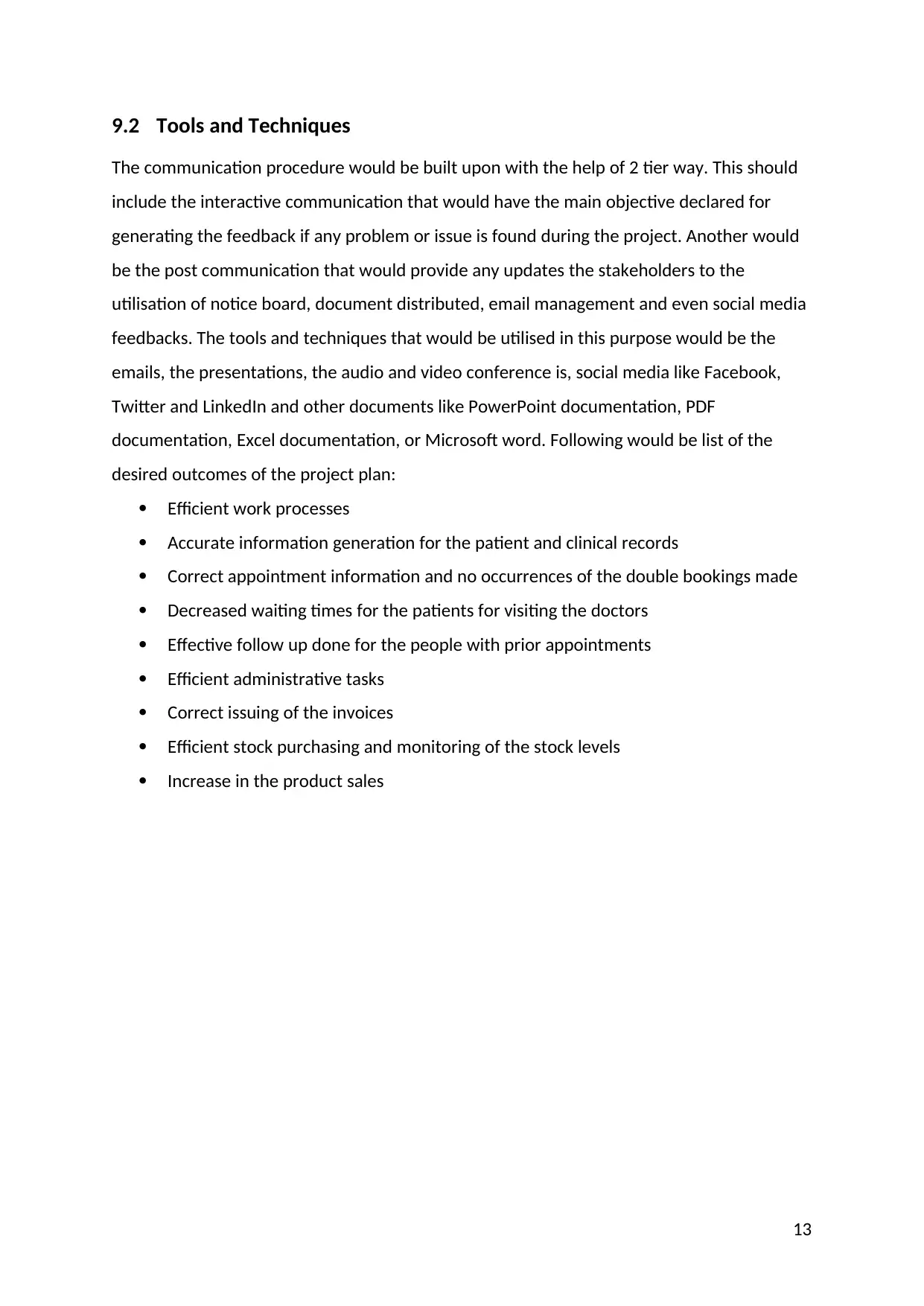
9.2 Tools and Techniques
The communication procedure would be built upon with the help of 2 tier way. This should
include the interactive communication that would have the main objective declared for
generating the feedback if any problem or issue is found during the project. Another would
be the post communication that would provide any updates the stakeholders to the
utilisation of notice board, document distributed, email management and even social media
feedbacks. The tools and techniques that would be utilised in this purpose would be the
emails, the presentations, the audio and video conference is, social media like Facebook,
Twitter and LinkedIn and other documents like PowerPoint documentation, PDF
documentation, Excel documentation, or Microsoft word. Following would be list of the
desired outcomes of the project plan:
Efficient work processes
Accurate information generation for the patient and clinical records
Correct appointment information and no occurrences of the double bookings made
Decreased waiting times for the patients for visiting the doctors
Effective follow up done for the people with prior appointments
Efficient administrative tasks
Correct issuing of the invoices
Efficient stock purchasing and monitoring of the stock levels
Increase in the product sales
13
The communication procedure would be built upon with the help of 2 tier way. This should
include the interactive communication that would have the main objective declared for
generating the feedback if any problem or issue is found during the project. Another would
be the post communication that would provide any updates the stakeholders to the
utilisation of notice board, document distributed, email management and even social media
feedbacks. The tools and techniques that would be utilised in this purpose would be the
emails, the presentations, the audio and video conference is, social media like Facebook,
Twitter and LinkedIn and other documents like PowerPoint documentation, PDF
documentation, Excel documentation, or Microsoft word. Following would be list of the
desired outcomes of the project plan:
Efficient work processes
Accurate information generation for the patient and clinical records
Correct appointment information and no occurrences of the double bookings made
Decreased waiting times for the patients for visiting the doctors
Effective follow up done for the people with prior appointments
Efficient administrative tasks
Correct issuing of the invoices
Efficient stock purchasing and monitoring of the stock levels
Increase in the product sales
13
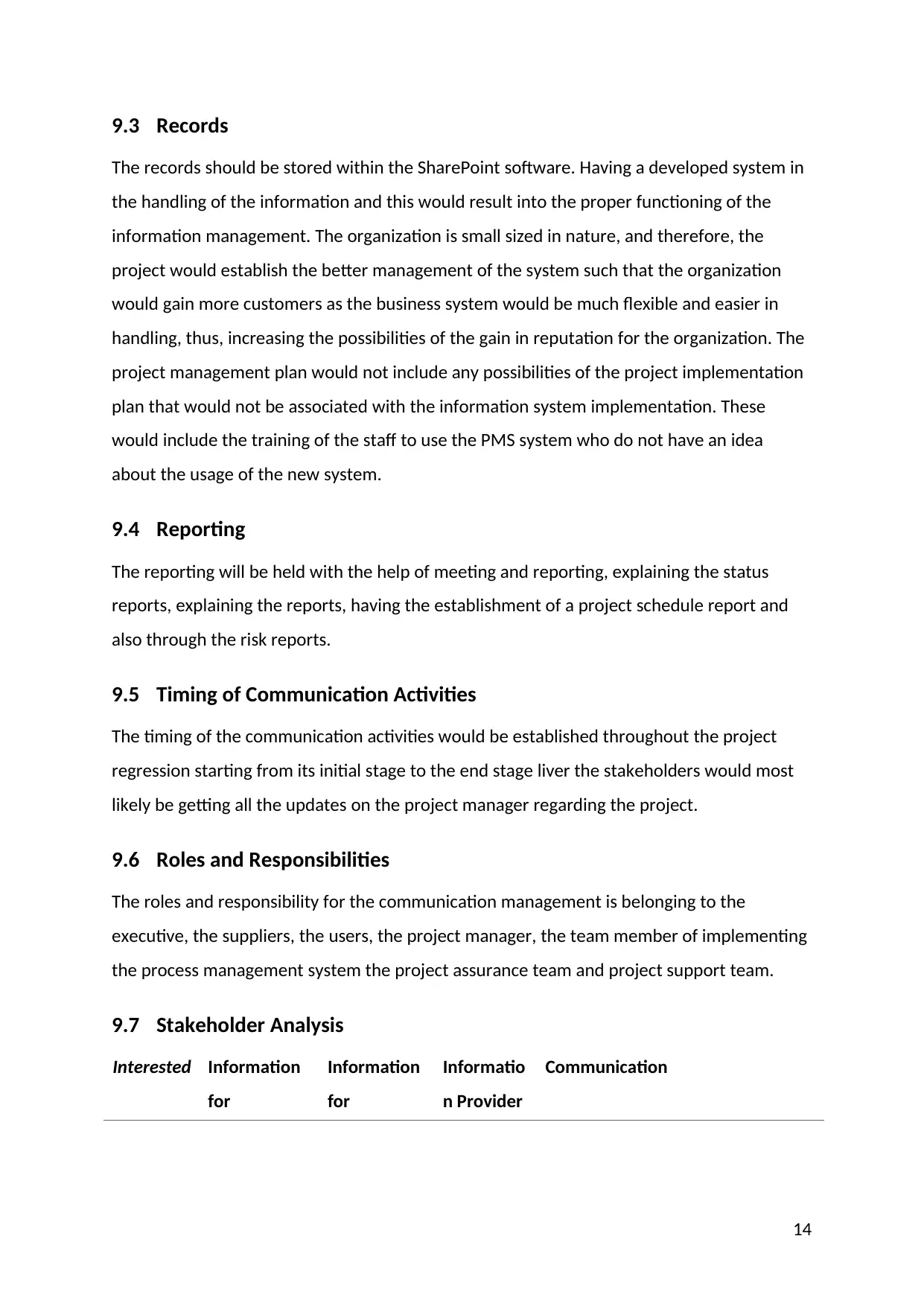
9.3 Records
The records should be stored within the SharePoint software. Having a developed system in
the handling of the information and this would result into the proper functioning of the
information management. The organization is small sized in nature, and therefore, the
project would establish the better management of the system such that the organization
would gain more customers as the business system would be much flexible and easier in
handling, thus, increasing the possibilities of the gain in reputation for the organization. The
project management plan would not include any possibilities of the project implementation
plan that would not be associated with the information system implementation. These
would include the training of the staff to use the PMS system who do not have an idea
about the usage of the new system.
9.4 Reporting
The reporting will be held with the help of meeting and reporting, explaining the status
reports, explaining the reports, having the establishment of a project schedule report and
also through the risk reports.
9.5 Timing of Communication Activities
The timing of the communication activities would be established throughout the project
regression starting from its initial stage to the end stage liver the stakeholders would most
likely be getting all the updates on the project manager regarding the project.
9.6 Roles and Responsibilities
The roles and responsibility for the communication management is belonging to the
executive, the suppliers, the users, the project manager, the team member of implementing
the process management system the project assurance team and project support team.
9.7 Stakeholder Analysis
Interested Information
for
Information
for
Informatio
n Provider
Communication
14
The records should be stored within the SharePoint software. Having a developed system in
the handling of the information and this would result into the proper functioning of the
information management. The organization is small sized in nature, and therefore, the
project would establish the better management of the system such that the organization
would gain more customers as the business system would be much flexible and easier in
handling, thus, increasing the possibilities of the gain in reputation for the organization. The
project management plan would not include any possibilities of the project implementation
plan that would not be associated with the information system implementation. These
would include the training of the staff to use the PMS system who do not have an idea
about the usage of the new system.
9.4 Reporting
The reporting will be held with the help of meeting and reporting, explaining the status
reports, explaining the reports, having the establishment of a project schedule report and
also through the risk reports.
9.5 Timing of Communication Activities
The timing of the communication activities would be established throughout the project
regression starting from its initial stage to the end stage liver the stakeholders would most
likely be getting all the updates on the project manager regarding the project.
9.6 Roles and Responsibilities
The roles and responsibility for the communication management is belonging to the
executive, the suppliers, the users, the project manager, the team member of implementing
the process management system the project assurance team and project support team.
9.7 Stakeholder Analysis
Interested Information
for
Information
for
Informatio
n Provider
Communication
14
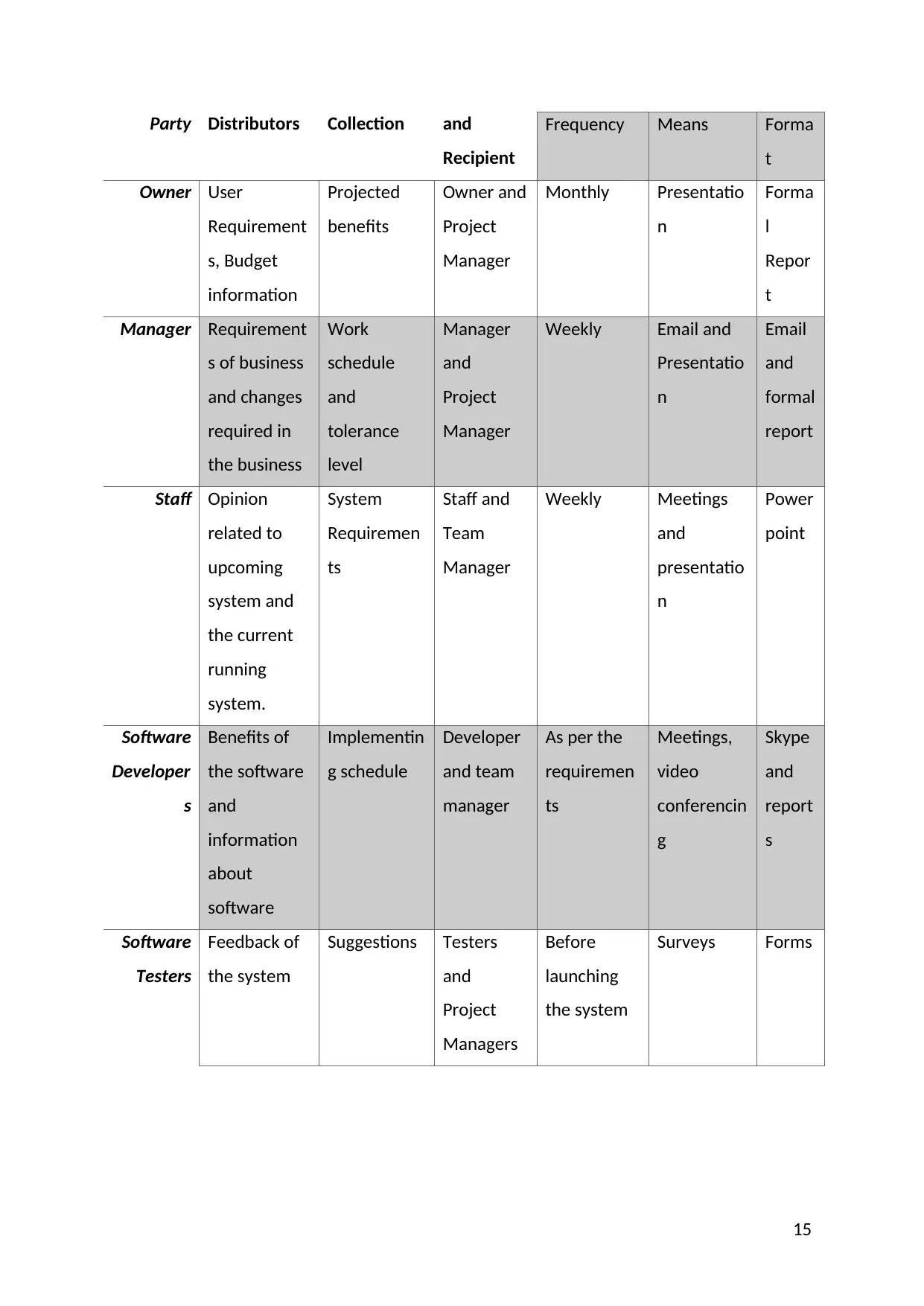
Party Distributors Collection and
Recipient
Frequency Means Forma
t
Owner User
Requirement
s, Budget
information
Projected
benefits
Owner and
Project
Manager
Monthly Presentatio
n
Forma
l
Repor
t
Manager Requirement
s of business
and changes
required in
the business
Work
schedule
and
tolerance
level
Manager
and
Project
Manager
Weekly Email and
Presentatio
n
Email
and
formal
report
Staff Opinion
related to
upcoming
system and
the current
running
system.
System
Requiremen
ts
Staff and
Team
Manager
Weekly Meetings
and
presentatio
n
Power
point
Software
Developer
s
Benefits of
the software
and
information
about
software
Implementin
g schedule
Developer
and team
manager
As per the
requiremen
ts
Meetings,
video
conferencin
g
Skype
and
report
s
Software
Testers
Feedback of
the system
Suggestions Testers
and
Project
Managers
Before
launching
the system
Surveys Forms
15
Recipient
Frequency Means Forma
t
Owner User
Requirement
s, Budget
information
Projected
benefits
Owner and
Project
Manager
Monthly Presentatio
n
Forma
l
Repor
t
Manager Requirement
s of business
and changes
required in
the business
Work
schedule
and
tolerance
level
Manager
and
Project
Manager
Weekly Email and
Presentatio
n
and
formal
report
Staff Opinion
related to
upcoming
system and
the current
running
system.
System
Requiremen
ts
Staff and
Team
Manager
Weekly Meetings
and
presentatio
n
Power
point
Software
Developer
s
Benefits of
the software
and
information
about
software
Implementin
g schedule
Developer
and team
manager
As per the
requiremen
ts
Meetings,
video
conferencin
g
Skype
and
report
s
Software
Testers
Feedback of
the system
Suggestions Testers
and
Project
Managers
Before
launching
the system
Surveys Forms
15
Secure Best Marks with AI Grader
Need help grading? Try our AI Grader for instant feedback on your assignments.
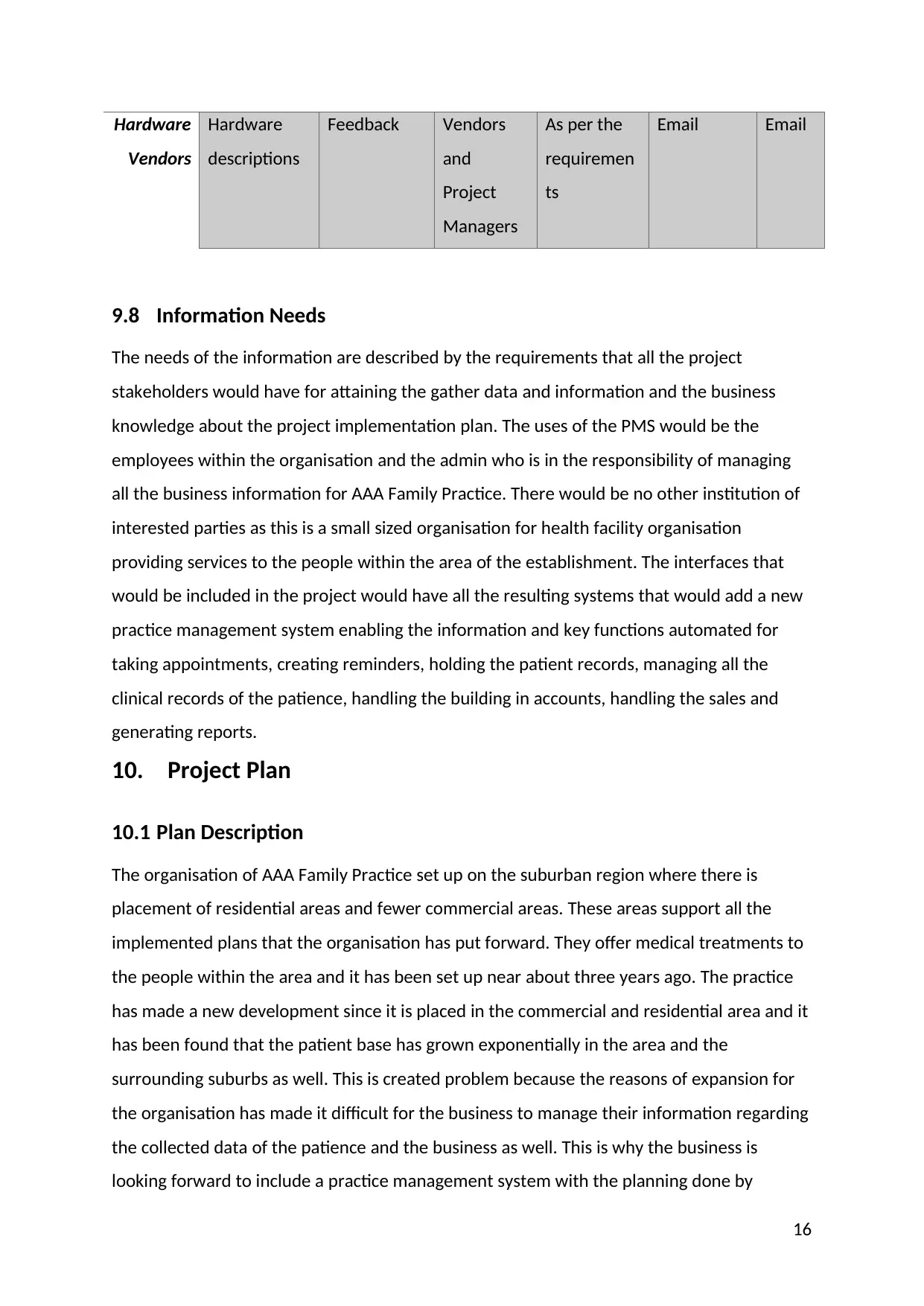
Hardware
Vendors
Hardware
descriptions
Feedback Vendors
and
Project
Managers
As per the
requiremen
ts
Email Email
9.8 Information Needs
The needs of the information are described by the requirements that all the project
stakeholders would have for attaining the gather data and information and the business
knowledge about the project implementation plan. The uses of the PMS would be the
employees within the organisation and the admin who is in the responsibility of managing
all the business information for AAA Family Practice. There would be no other institution of
interested parties as this is a small sized organisation for health facility organisation
providing services to the people within the area of the establishment. The interfaces that
would be included in the project would have all the resulting systems that would add a new
practice management system enabling the information and key functions automated for
taking appointments, creating reminders, holding the patient records, managing all the
clinical records of the patience, handling the building in accounts, handling the sales and
generating reports.
10. Project Plan
10.1 Plan Description
The organisation of AAA Family Practice set up on the suburban region where there is
placement of residential areas and fewer commercial areas. These areas support all the
implemented plans that the organisation has put forward. They offer medical treatments to
the people within the area and it has been set up near about three years ago. The practice
has made a new development since it is placed in the commercial and residential area and it
has been found that the patient base has grown exponentially in the area and the
surrounding suburbs as well. This is created problem because the reasons of expansion for
the organisation has made it difficult for the business to manage their information regarding
the collected data of the patience and the business as well. This is why the business is
looking forward to include a practice management system with the planning done by
16
Vendors
Hardware
descriptions
Feedback Vendors
and
Project
Managers
As per the
requiremen
ts
Email Email
9.8 Information Needs
The needs of the information are described by the requirements that all the project
stakeholders would have for attaining the gather data and information and the business
knowledge about the project implementation plan. The uses of the PMS would be the
employees within the organisation and the admin who is in the responsibility of managing
all the business information for AAA Family Practice. There would be no other institution of
interested parties as this is a small sized organisation for health facility organisation
providing services to the people within the area of the establishment. The interfaces that
would be included in the project would have all the resulting systems that would add a new
practice management system enabling the information and key functions automated for
taking appointments, creating reminders, holding the patient records, managing all the
clinical records of the patience, handling the building in accounts, handling the sales and
generating reports.
10. Project Plan
10.1 Plan Description
The organisation of AAA Family Practice set up on the suburban region where there is
placement of residential areas and fewer commercial areas. These areas support all the
implemented plans that the organisation has put forward. They offer medical treatments to
the people within the area and it has been set up near about three years ago. The practice
has made a new development since it is placed in the commercial and residential area and it
has been found that the patient base has grown exponentially in the area and the
surrounding suburbs as well. This is created problem because the reasons of expansion for
the organisation has made it difficult for the business to manage their information regarding
the collected data of the patience and the business as well. This is why the business is
looking forward to include a practice management system with the planning done by
16
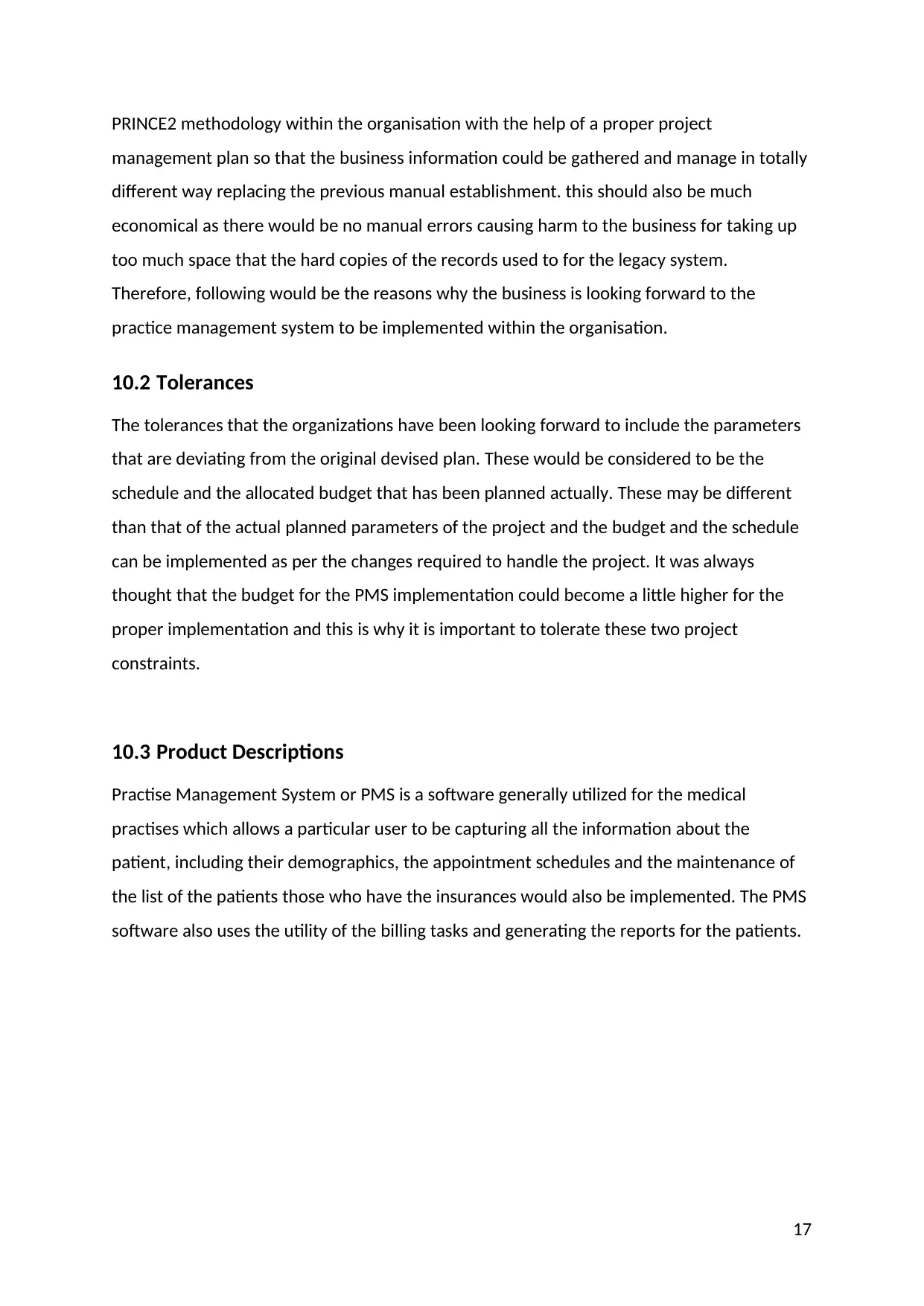
PRINCE2 methodology within the organisation with the help of a proper project
management plan so that the business information could be gathered and manage in totally
different way replacing the previous manual establishment. this should also be much
economical as there would be no manual errors causing harm to the business for taking up
too much space that the hard copies of the records used to for the legacy system.
Therefore, following would be the reasons why the business is looking forward to the
practice management system to be implemented within the organisation.
10.2 Tolerances
The tolerances that the organizations have been looking forward to include the parameters
that are deviating from the original devised plan. These would be considered to be the
schedule and the allocated budget that has been planned actually. These may be different
than that of the actual planned parameters of the project and the budget and the schedule
can be implemented as per the changes required to handle the project. It was always
thought that the budget for the PMS implementation could become a little higher for the
proper implementation and this is why it is important to tolerate these two project
constraints.
10.3 Product Descriptions
Practise Management System or PMS is a software generally utilized for the medical
practises which allows a particular user to be capturing all the information about the
patient, including their demographics, the appointment schedules and the maintenance of
the list of the patients those who have the insurances would also be implemented. The PMS
software also uses the utility of the billing tasks and generating the reports for the patients.
17
management plan so that the business information could be gathered and manage in totally
different way replacing the previous manual establishment. this should also be much
economical as there would be no manual errors causing harm to the business for taking up
too much space that the hard copies of the records used to for the legacy system.
Therefore, following would be the reasons why the business is looking forward to the
practice management system to be implemented within the organisation.
10.2 Tolerances
The tolerances that the organizations have been looking forward to include the parameters
that are deviating from the original devised plan. These would be considered to be the
schedule and the allocated budget that has been planned actually. These may be different
than that of the actual planned parameters of the project and the budget and the schedule
can be implemented as per the changes required to handle the project. It was always
thought that the budget for the PMS implementation could become a little higher for the
proper implementation and this is why it is important to tolerate these two project
constraints.
10.3 Product Descriptions
Practise Management System or PMS is a software generally utilized for the medical
practises which allows a particular user to be capturing all the information about the
patient, including their demographics, the appointment schedules and the maintenance of
the list of the patients those who have the insurances would also be implemented. The PMS
software also uses the utility of the billing tasks and generating the reports for the patients.
17
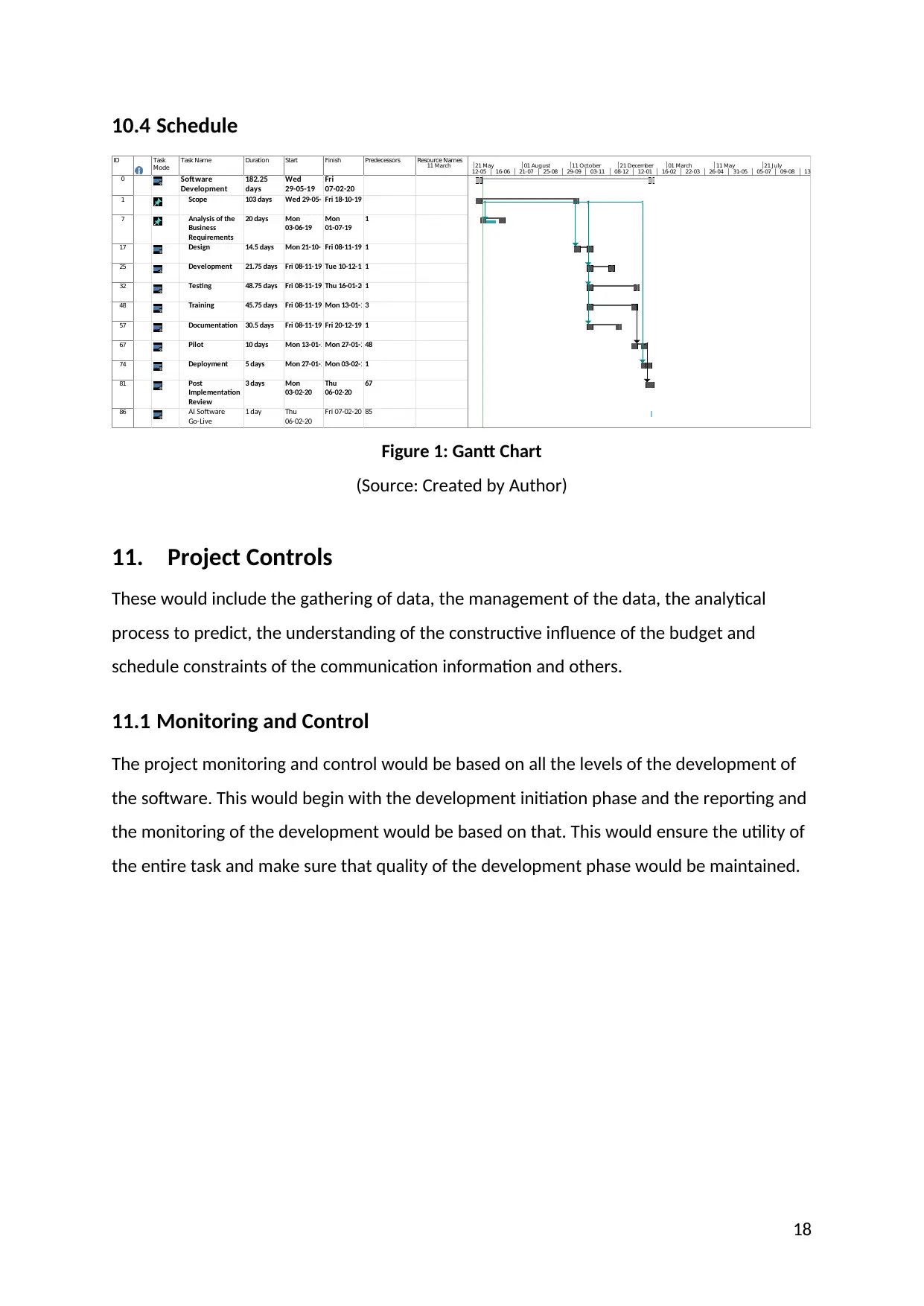
10.4 Schedule
ID Task
Mode
Task Name Duration Start Finish Predecessors Resource Names
0 Software
Development
Plan
182.25
days
Wed
29-05-19
Fri
07-02-20
1 Scope 103 days Wed 29-05-19Fri 18-10-19
7 Analysis of the
Business
Requirements
20 days Mon
03-06-19
Mon
01-07-19
1
17 Design 14.5 days Mon 21-10-19Fri 08-11-19 1
25 Development 21.75 days Fri 08-11-19 Tue 10-12-191
32 Testing 48.75 days Fri 08-11-19 Thu 16-01-201
48 Training 45.75 days Fri 08-11-19 Mon 13-01-203
57 Documentation 30.5 days Fri 08-11-19 Fri 20-12-19 1
67 Pilot 10 days Mon 13-01-20Mon 27-01-2048
74 Deployment 5 days Mon 27-01-20Mon 03-02-201
81 Post
Implementation
Review
3 days Mon
03-02-20
Thu
06-02-20
67
86 AI Software
Go-Live
1 day Thu
06-02-20
Fri 07-02-20 85
12-05 16-06 21-07 25-08 29-09 03-11 08-12 12-01 16-02 22-03 26-04 31-05 05-07 09-08 13-09
11 March 21 May 01 August 11 October 21 December 01 March 11 May 21 July
Figure 1: Gantt Chart
(Source: Created by Author)
11. Project Controls
These would include the gathering of data, the management of the data, the analytical
process to predict, the understanding of the constructive influence of the budget and
schedule constraints of the communication information and others.
11.1 Monitoring and Control
The project monitoring and control would be based on all the levels of the development of
the software. This would begin with the development initiation phase and the reporting and
the monitoring of the development would be based on that. This would ensure the utility of
the entire task and make sure that quality of the development phase would be maintained.
18
ID Task
Mode
Task Name Duration Start Finish Predecessors Resource Names
0 Software
Development
Plan
182.25
days
Wed
29-05-19
Fri
07-02-20
1 Scope 103 days Wed 29-05-19Fri 18-10-19
7 Analysis of the
Business
Requirements
20 days Mon
03-06-19
Mon
01-07-19
1
17 Design 14.5 days Mon 21-10-19Fri 08-11-19 1
25 Development 21.75 days Fri 08-11-19 Tue 10-12-191
32 Testing 48.75 days Fri 08-11-19 Thu 16-01-201
48 Training 45.75 days Fri 08-11-19 Mon 13-01-203
57 Documentation 30.5 days Fri 08-11-19 Fri 20-12-19 1
67 Pilot 10 days Mon 13-01-20Mon 27-01-2048
74 Deployment 5 days Mon 27-01-20Mon 03-02-201
81 Post
Implementation
Review
3 days Mon
03-02-20
Thu
06-02-20
67
86 AI Software
Go-Live
1 day Thu
06-02-20
Fri 07-02-20 85
12-05 16-06 21-07 25-08 29-09 03-11 08-12 12-01 16-02 22-03 26-04 31-05 05-07 09-08 13-09
11 March 21 May 01 August 11 October 21 December 01 March 11 May 21 July
Figure 1: Gantt Chart
(Source: Created by Author)
11. Project Controls
These would include the gathering of data, the management of the data, the analytical
process to predict, the understanding of the constructive influence of the budget and
schedule constraints of the communication information and others.
11.1 Monitoring and Control
The project monitoring and control would be based on all the levels of the development of
the software. This would begin with the development initiation phase and the reporting and
the monitoring of the development would be based on that. This would ensure the utility of
the entire task and make sure that quality of the development phase would be maintained.
18
Paraphrase This Document
Need a fresh take? Get an instant paraphrase of this document with our AI Paraphraser
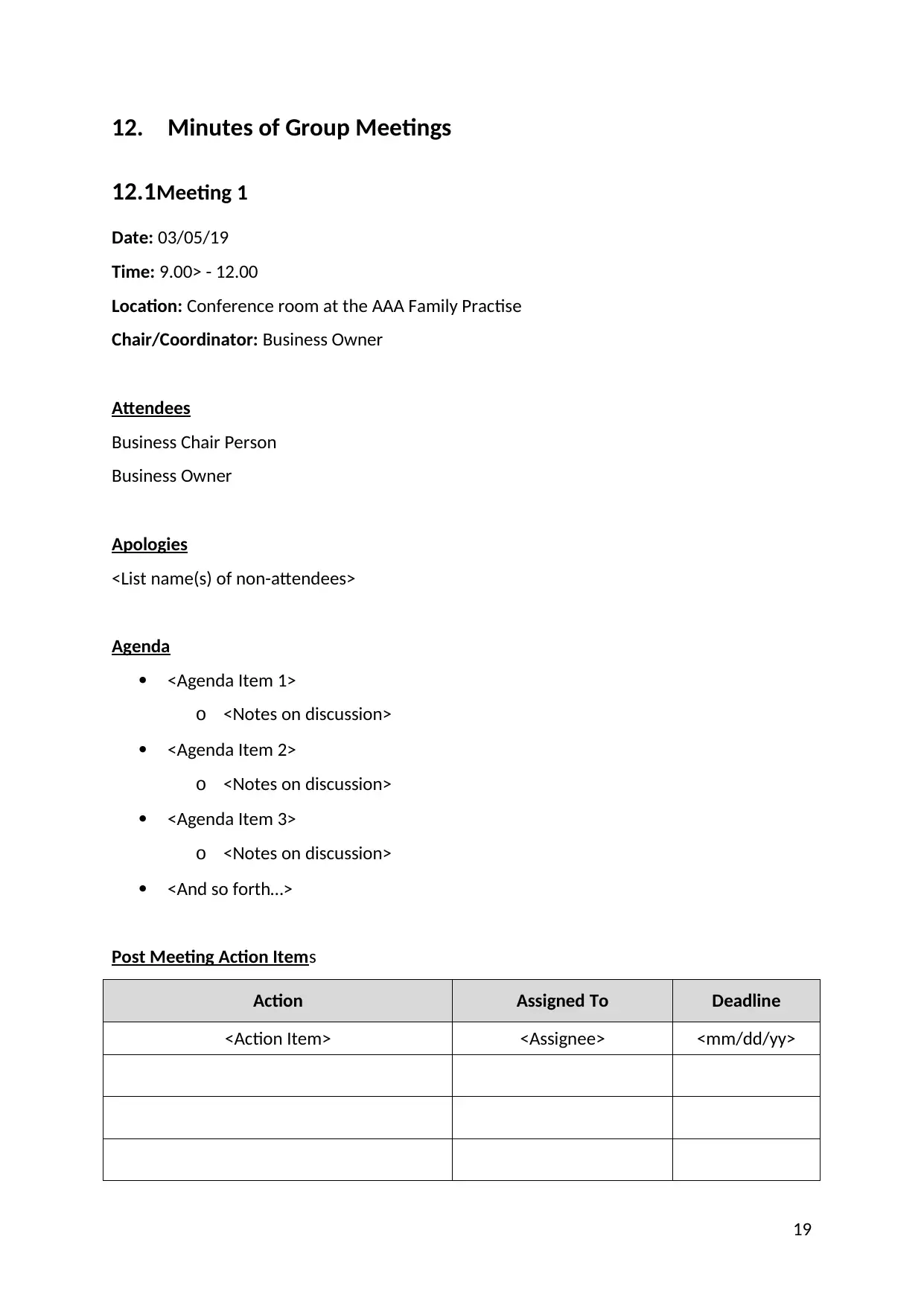
12. Minutes of Group Meetings
12.1Meeting 1
Date: 03/05/19
Time: 9.00> - 12.00
Location: Conference room at the AAA Family Practise
Chair/Coordinator: Business Owner
Attendees
Business Chair Person
Business Owner
Apologies
<List name(s) of non-attendees>
Agenda
<Agenda Item 1>
o <Notes on discussion>
<Agenda Item 2>
o <Notes on discussion>
<Agenda Item 3>
o <Notes on discussion>
<And so forth…>
Post Meeting Action Items
Action Assigned To Deadline
<Action Item> <Assignee> <mm/dd/yy>
19
12.1Meeting 1
Date: 03/05/19
Time: 9.00> - 12.00
Location: Conference room at the AAA Family Practise
Chair/Coordinator: Business Owner
Attendees
Business Chair Person
Business Owner
Apologies
<List name(s) of non-attendees>
Agenda
<Agenda Item 1>
o <Notes on discussion>
<Agenda Item 2>
o <Notes on discussion>
<Agenda Item 3>
o <Notes on discussion>
<And so forth…>
Post Meeting Action Items
Action Assigned To Deadline
<Action Item> <Assignee> <mm/dd/yy>
19
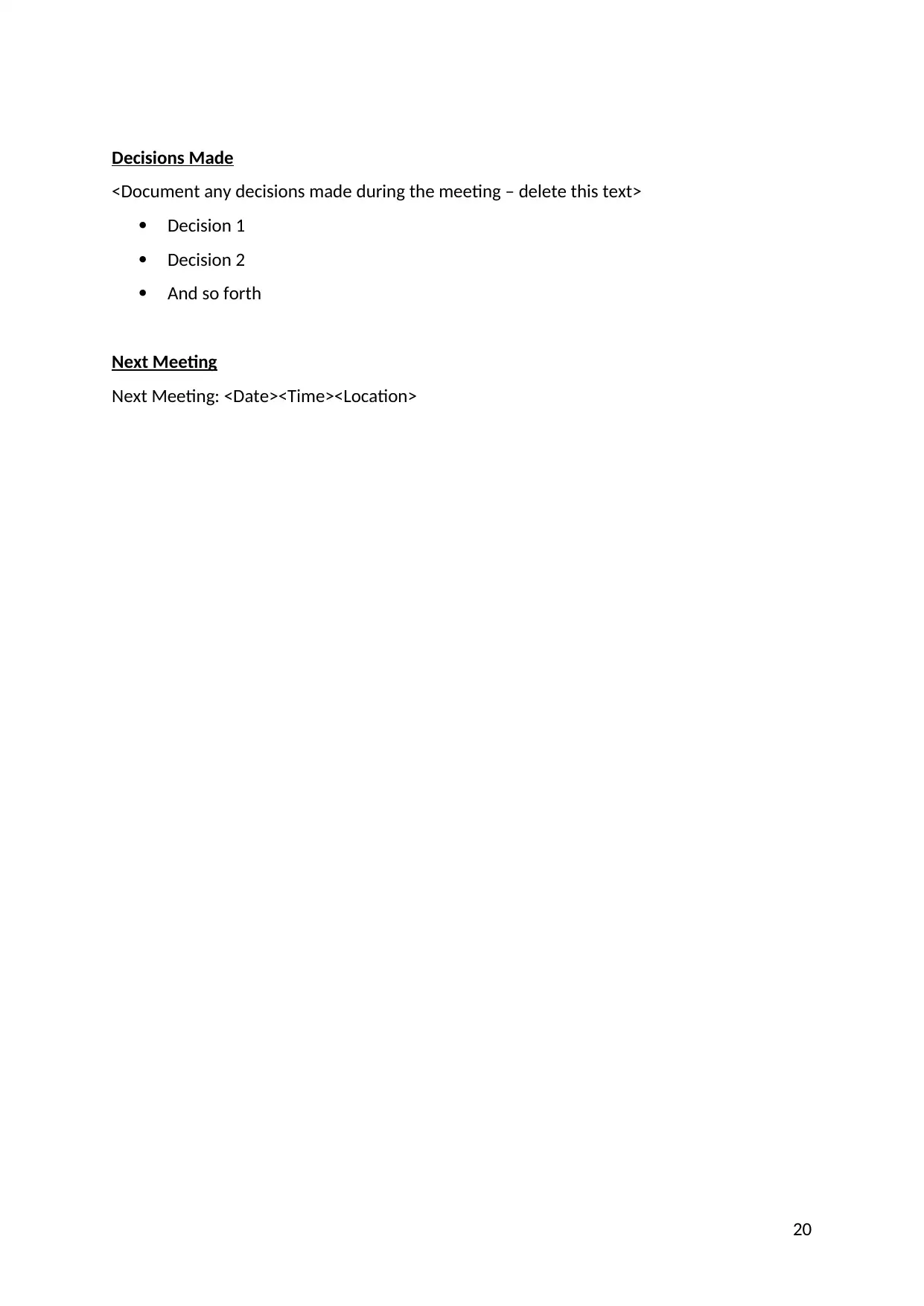
Decisions Made
<Document any decisions made during the meeting – delete this text>
Decision 1
Decision 2
And so forth
Next Meeting
Next Meeting: <Date><Time><Location>
20
<Document any decisions made during the meeting – delete this text>
Decision 1
Decision 2
And so forth
Next Meeting
Next Meeting: <Date><Time><Location>
20
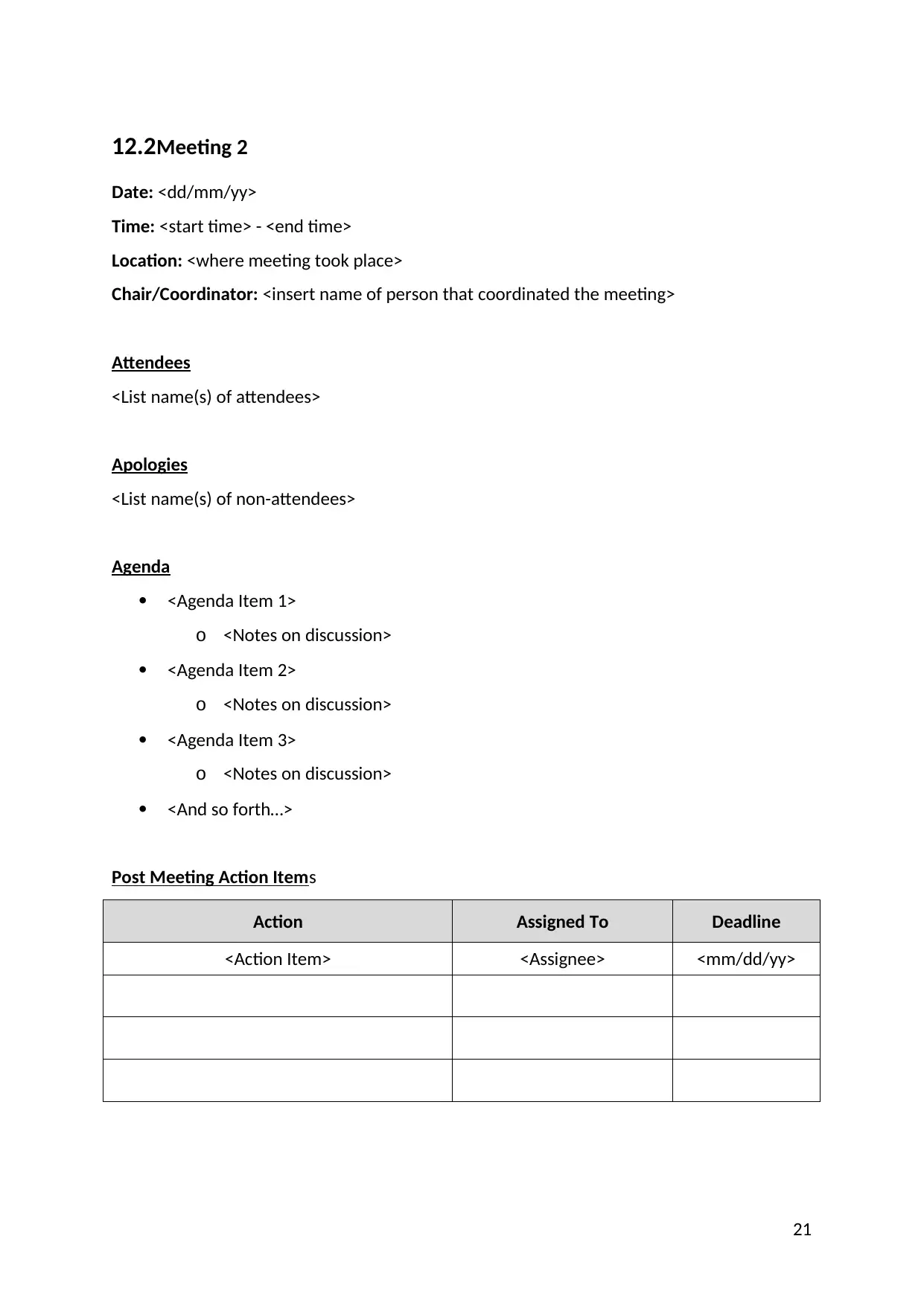
12.2Meeting 2
Date: <dd/mm/yy>
Time: <start time> - <end time>
Location: <where meeting took place>
Chair/Coordinator: <insert name of person that coordinated the meeting>
Attendees
<List name(s) of attendees>
Apologies
<List name(s) of non-attendees>
Agenda
<Agenda Item 1>
o <Notes on discussion>
<Agenda Item 2>
o <Notes on discussion>
<Agenda Item 3>
o <Notes on discussion>
<And so forth…>
Post Meeting Action Items
Action Assigned To Deadline
<Action Item> <Assignee> <mm/dd/yy>
21
Date: <dd/mm/yy>
Time: <start time> - <end time>
Location: <where meeting took place>
Chair/Coordinator: <insert name of person that coordinated the meeting>
Attendees
<List name(s) of attendees>
Apologies
<List name(s) of non-attendees>
Agenda
<Agenda Item 1>
o <Notes on discussion>
<Agenda Item 2>
o <Notes on discussion>
<Agenda Item 3>
o <Notes on discussion>
<And so forth…>
Post Meeting Action Items
Action Assigned To Deadline
<Action Item> <Assignee> <mm/dd/yy>
21
Secure Best Marks with AI Grader
Need help grading? Try our AI Grader for instant feedback on your assignments.
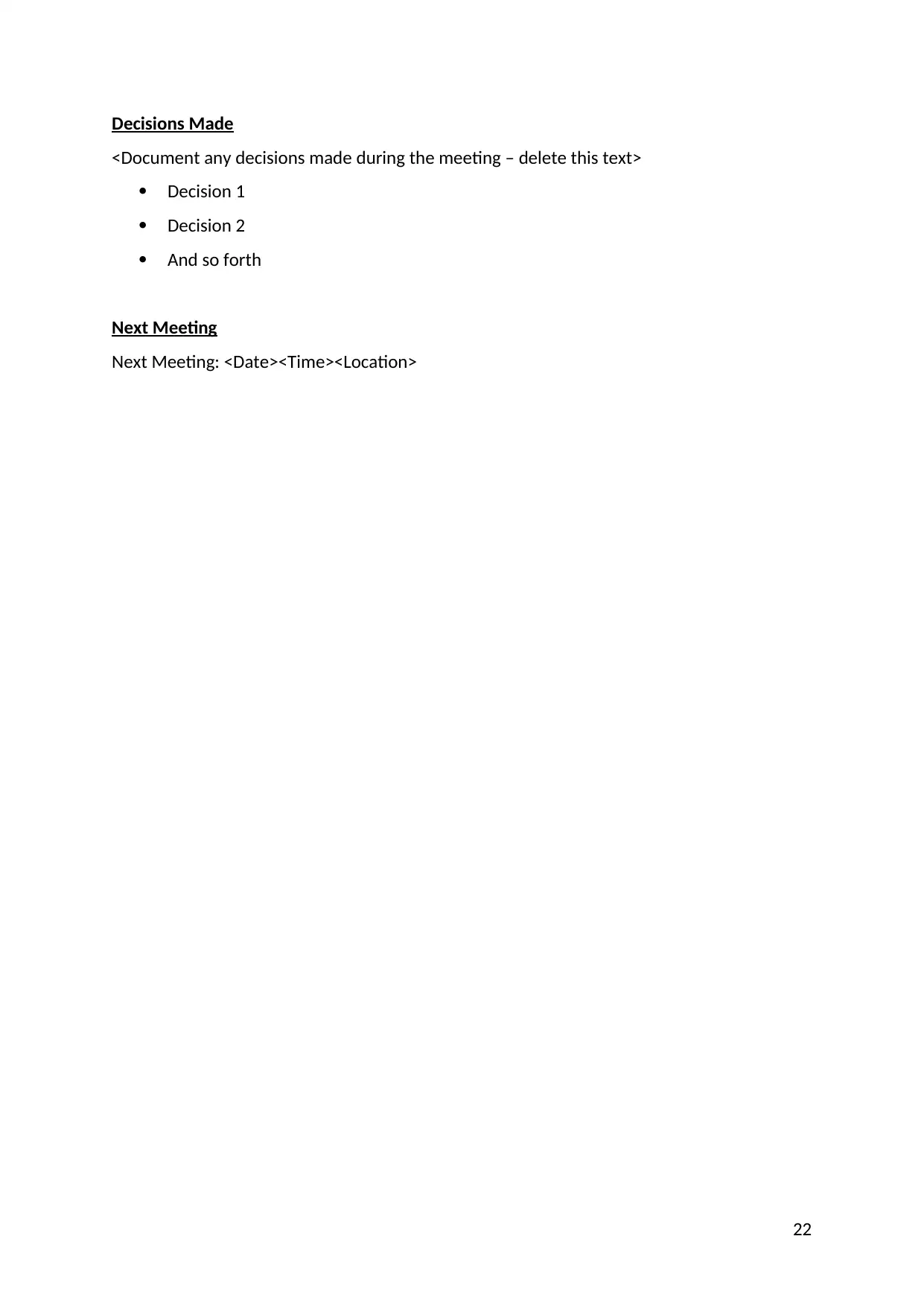
Decisions Made
<Document any decisions made during the meeting – delete this text>
Decision 1
Decision 2
And so forth
Next Meeting
Next Meeting: <Date><Time><Location>
22
<Document any decisions made during the meeting – delete this text>
Decision 1
Decision 2
And so forth
Next Meeting
Next Meeting: <Date><Time><Location>
22
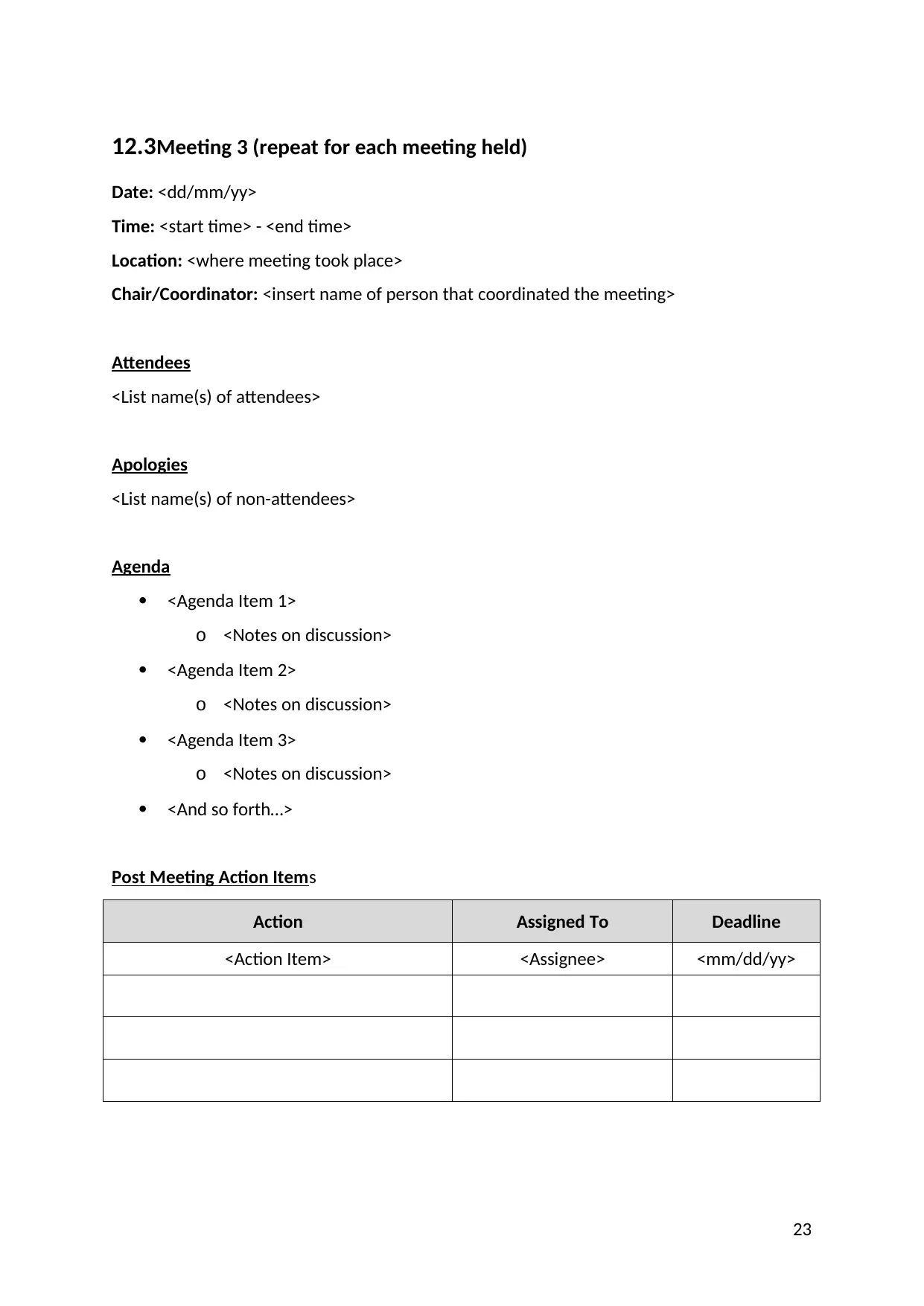
12.3Meeting 3 (repeat for each meeting held)
Date: <dd/mm/yy>
Time: <start time> - <end time>
Location: <where meeting took place>
Chair/Coordinator: <insert name of person that coordinated the meeting>
Attendees
<List name(s) of attendees>
Apologies
<List name(s) of non-attendees>
Agenda
<Agenda Item 1>
o <Notes on discussion>
<Agenda Item 2>
o <Notes on discussion>
<Agenda Item 3>
o <Notes on discussion>
<And so forth…>
Post Meeting Action Items
Action Assigned To Deadline
<Action Item> <Assignee> <mm/dd/yy>
23
Date: <dd/mm/yy>
Time: <start time> - <end time>
Location: <where meeting took place>
Chair/Coordinator: <insert name of person that coordinated the meeting>
Attendees
<List name(s) of attendees>
Apologies
<List name(s) of non-attendees>
Agenda
<Agenda Item 1>
o <Notes on discussion>
<Agenda Item 2>
o <Notes on discussion>
<Agenda Item 3>
o <Notes on discussion>
<And so forth…>
Post Meeting Action Items
Action Assigned To Deadline
<Action Item> <Assignee> <mm/dd/yy>
23
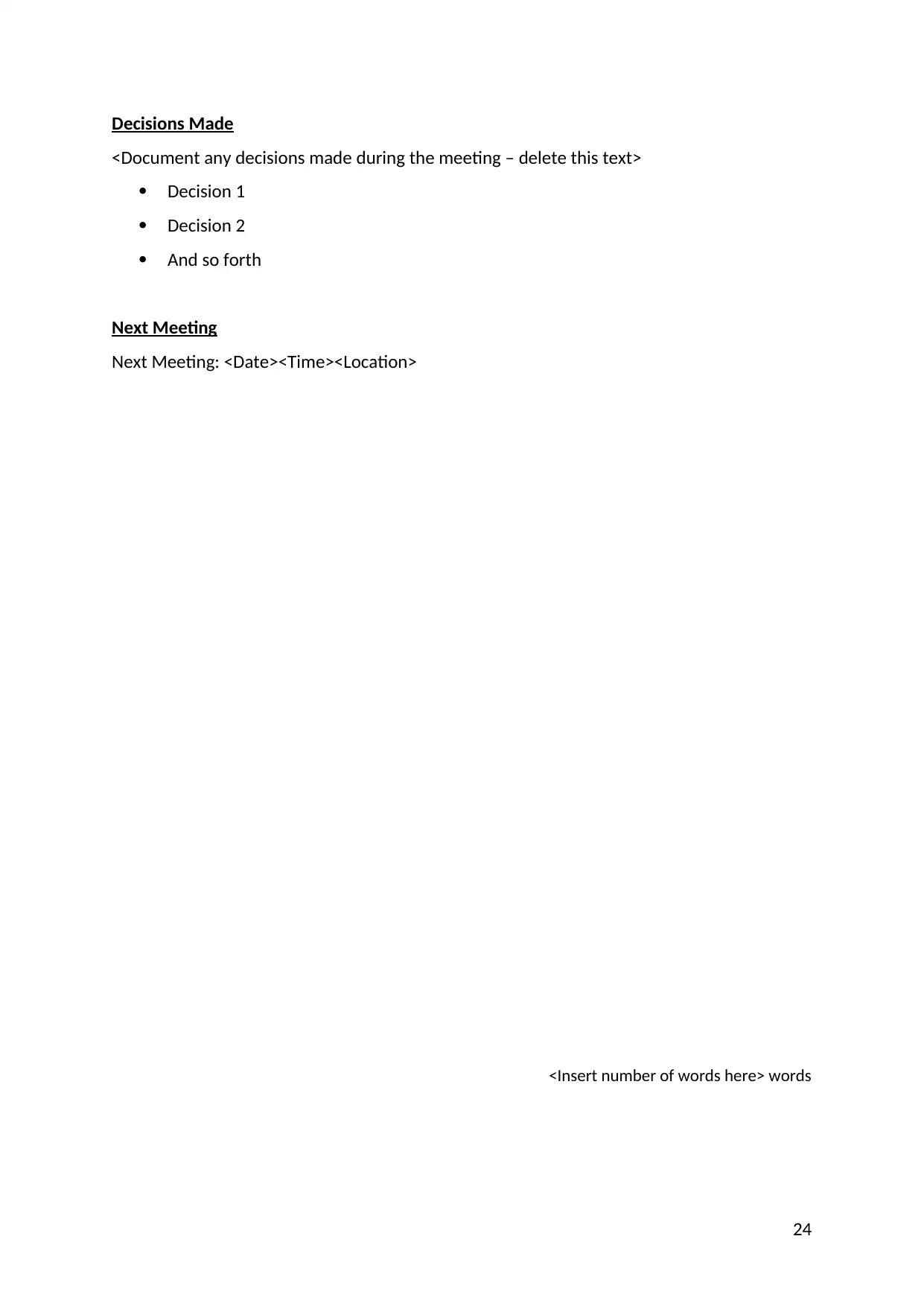
Decisions Made
<Document any decisions made during the meeting – delete this text>
Decision 1
Decision 2
And so forth
Next Meeting
Next Meeting: <Date><Time><Location>
<Insert number of words here> words
24
<Document any decisions made during the meeting – delete this text>
Decision 1
Decision 2
And so forth
Next Meeting
Next Meeting: <Date><Time><Location>
<Insert number of words here> words
24
Paraphrase This Document
Need a fresh take? Get an instant paraphrase of this document with our AI Paraphraser
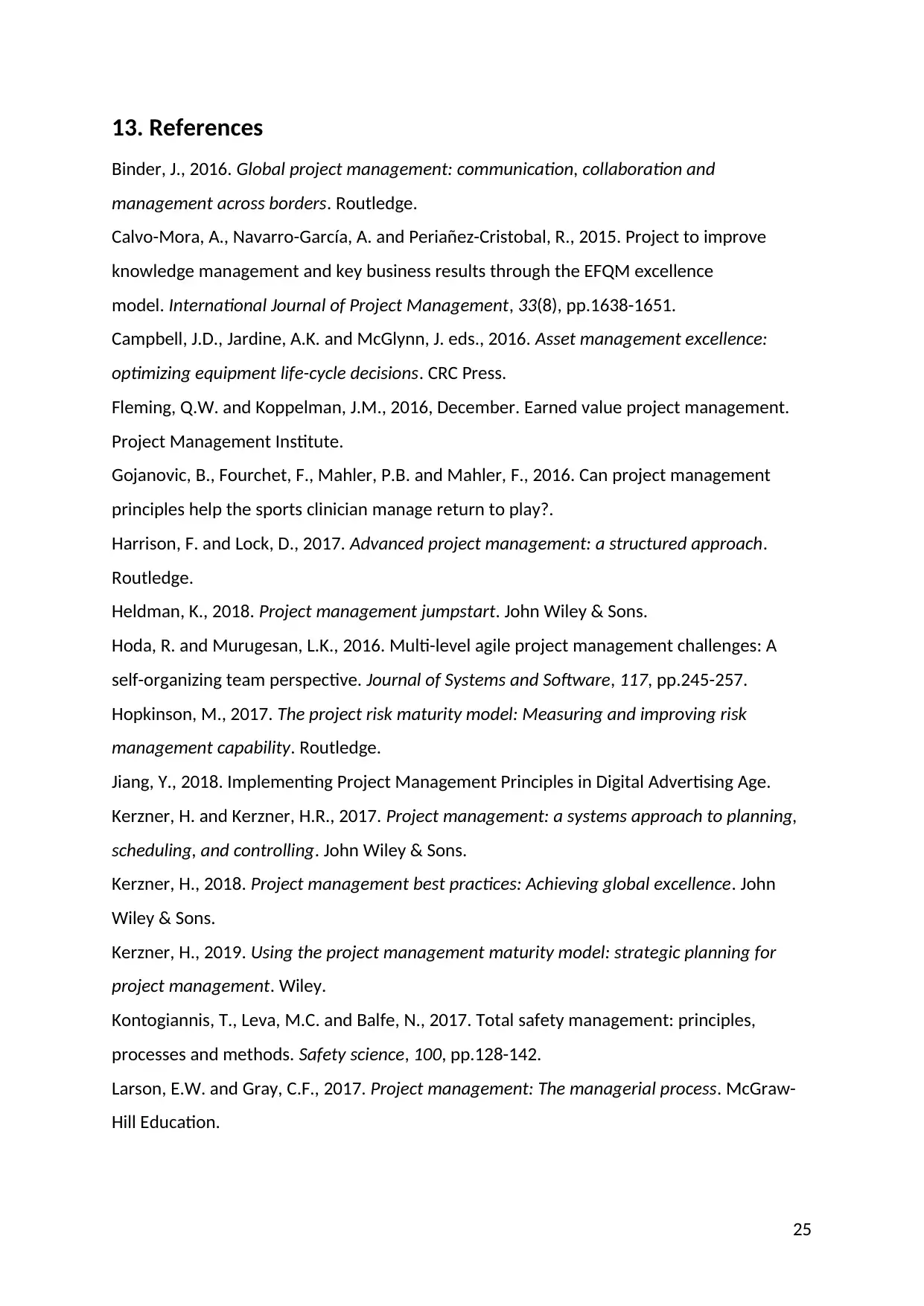
13. References
Binder, J., 2016. Global project management: communication, collaboration and
management across borders. Routledge.
Calvo-Mora, A., Navarro-García, A. and Periañez-Cristobal, R., 2015. Project to improve
knowledge management and key business results through the EFQM excellence
model. International Journal of Project Management, 33(8), pp.1638-1651.
Campbell, J.D., Jardine, A.K. and McGlynn, J. eds., 2016. Asset management excellence:
optimizing equipment life-cycle decisions. CRC Press.
Fleming, Q.W. and Koppelman, J.M., 2016, December. Earned value project management.
Project Management Institute.
Gojanovic, B., Fourchet, F., Mahler, P.B. and Mahler, F., 2016. Can project management
principles help the sports clinician manage return to play?.
Harrison, F. and Lock, D., 2017. Advanced project management: a structured approach.
Routledge.
Heldman, K., 2018. Project management jumpstart. John Wiley & Sons.
Hoda, R. and Murugesan, L.K., 2016. Multi-level agile project management challenges: A
self-organizing team perspective. Journal of Systems and Software, 117, pp.245-257.
Hopkinson, M., 2017. The project risk maturity model: Measuring and improving risk
management capability. Routledge.
Jiang, Y., 2018. Implementing Project Management Principles in Digital Advertising Age.
Kerzner, H. and Kerzner, H.R., 2017. Project management: a systems approach to planning,
scheduling, and controlling. John Wiley & Sons.
Kerzner, H., 2018. Project management best practices: Achieving global excellence. John
Wiley & Sons.
Kerzner, H., 2019. Using the project management maturity model: strategic planning for
project management. Wiley.
Kontogiannis, T., Leva, M.C. and Balfe, N., 2017. Total safety management: principles,
processes and methods. Safety science, 100, pp.128-142.
Larson, E.W. and Gray, C.F., 2017. Project management: The managerial process. McGraw-
Hill Education.
25
Binder, J., 2016. Global project management: communication, collaboration and
management across borders. Routledge.
Calvo-Mora, A., Navarro-García, A. and Periañez-Cristobal, R., 2015. Project to improve
knowledge management and key business results through the EFQM excellence
model. International Journal of Project Management, 33(8), pp.1638-1651.
Campbell, J.D., Jardine, A.K. and McGlynn, J. eds., 2016. Asset management excellence:
optimizing equipment life-cycle decisions. CRC Press.
Fleming, Q.W. and Koppelman, J.M., 2016, December. Earned value project management.
Project Management Institute.
Gojanovic, B., Fourchet, F., Mahler, P.B. and Mahler, F., 2016. Can project management
principles help the sports clinician manage return to play?.
Harrison, F. and Lock, D., 2017. Advanced project management: a structured approach.
Routledge.
Heldman, K., 2018. Project management jumpstart. John Wiley & Sons.
Hoda, R. and Murugesan, L.K., 2016. Multi-level agile project management challenges: A
self-organizing team perspective. Journal of Systems and Software, 117, pp.245-257.
Hopkinson, M., 2017. The project risk maturity model: Measuring and improving risk
management capability. Routledge.
Jiang, Y., 2018. Implementing Project Management Principles in Digital Advertising Age.
Kerzner, H. and Kerzner, H.R., 2017. Project management: a systems approach to planning,
scheduling, and controlling. John Wiley & Sons.
Kerzner, H., 2018. Project management best practices: Achieving global excellence. John
Wiley & Sons.
Kerzner, H., 2019. Using the project management maturity model: strategic planning for
project management. Wiley.
Kontogiannis, T., Leva, M.C. and Balfe, N., 2017. Total safety management: principles,
processes and methods. Safety science, 100, pp.128-142.
Larson, E.W. and Gray, C.F., 2017. Project management: The managerial process. McGraw-
Hill Education.
25
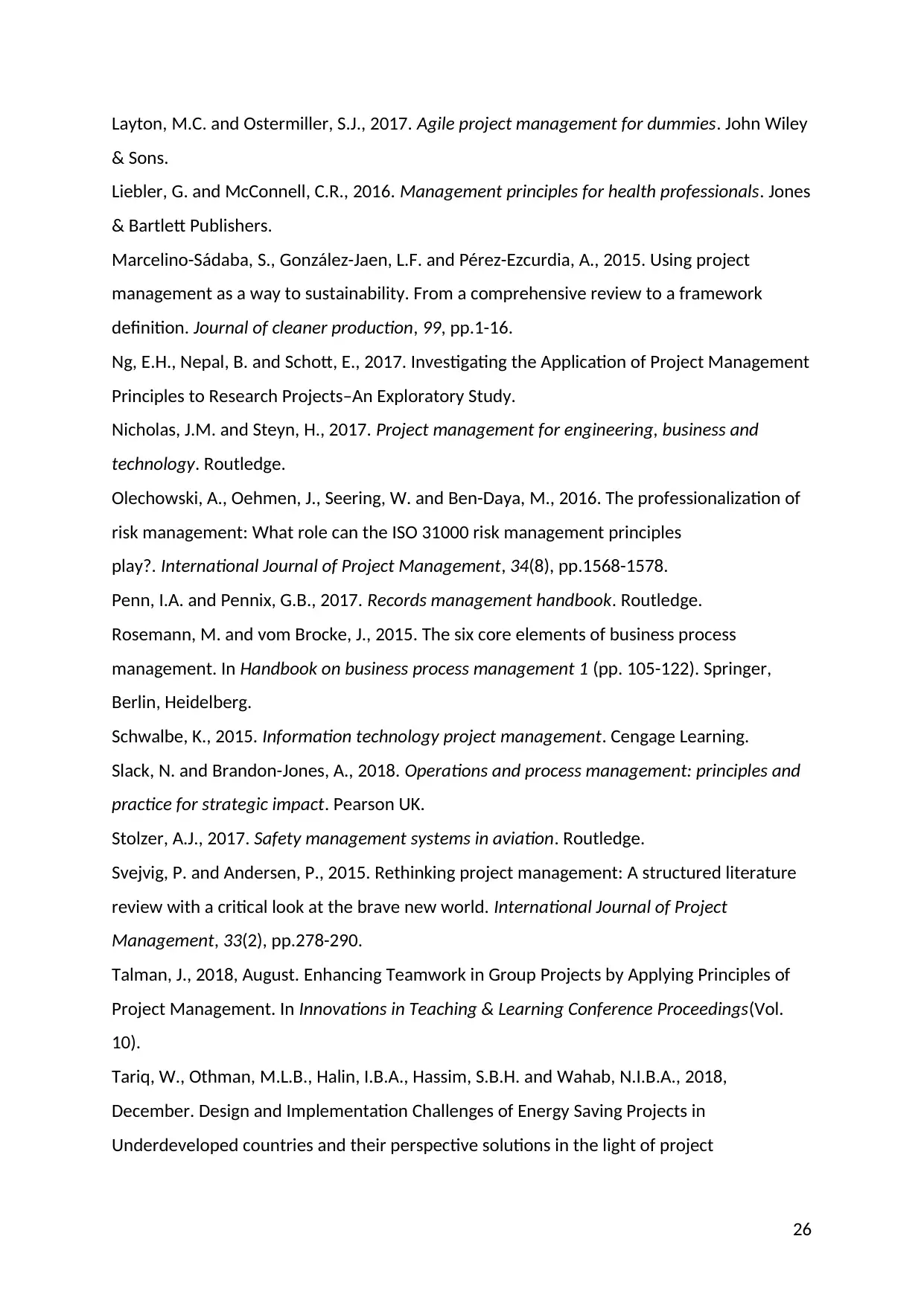
Layton, M.C. and Ostermiller, S.J., 2017. Agile project management for dummies. John Wiley
& Sons.
Liebler, G. and McConnell, C.R., 2016. Management principles for health professionals. Jones
& Bartlett Publishers.
Marcelino-Sádaba, S., González-Jaen, L.F. and Pérez-Ezcurdia, A., 2015. Using project
management as a way to sustainability. From a comprehensive review to a framework
definition. Journal of cleaner production, 99, pp.1-16.
Ng, E.H., Nepal, B. and Schott, E., 2017. Investigating the Application of Project Management
Principles to Research Projects–An Exploratory Study.
Nicholas, J.M. and Steyn, H., 2017. Project management for engineering, business and
technology. Routledge.
Olechowski, A., Oehmen, J., Seering, W. and Ben-Daya, M., 2016. The professionalization of
risk management: What role can the ISO 31000 risk management principles
play?. International Journal of Project Management, 34(8), pp.1568-1578.
Penn, I.A. and Pennix, G.B., 2017. Records management handbook. Routledge.
Rosemann, M. and vom Brocke, J., 2015. The six core elements of business process
management. In Handbook on business process management 1 (pp. 105-122). Springer,
Berlin, Heidelberg.
Schwalbe, K., 2015. Information technology project management. Cengage Learning.
Slack, N. and Brandon-Jones, A., 2018. Operations and process management: principles and
practice for strategic impact. Pearson UK.
Stolzer, A.J., 2017. Safety management systems in aviation. Routledge.
Svejvig, P. and Andersen, P., 2015. Rethinking project management: A structured literature
review with a critical look at the brave new world. International Journal of Project
Management, 33(2), pp.278-290.
Talman, J., 2018, August. Enhancing Teamwork in Group Projects by Applying Principles of
Project Management. In Innovations in Teaching & Learning Conference Proceedings(Vol.
10).
Tariq, W., Othman, M.L.B., Halin, I.B.A., Hassim, S.B.H. and Wahab, N.I.B.A., 2018,
December. Design and Implementation Challenges of Energy Saving Projects in
Underdeveloped countries and their perspective solutions in the light of project
26
& Sons.
Liebler, G. and McConnell, C.R., 2016. Management principles for health professionals. Jones
& Bartlett Publishers.
Marcelino-Sádaba, S., González-Jaen, L.F. and Pérez-Ezcurdia, A., 2015. Using project
management as a way to sustainability. From a comprehensive review to a framework
definition. Journal of cleaner production, 99, pp.1-16.
Ng, E.H., Nepal, B. and Schott, E., 2017. Investigating the Application of Project Management
Principles to Research Projects–An Exploratory Study.
Nicholas, J.M. and Steyn, H., 2017. Project management for engineering, business and
technology. Routledge.
Olechowski, A., Oehmen, J., Seering, W. and Ben-Daya, M., 2016. The professionalization of
risk management: What role can the ISO 31000 risk management principles
play?. International Journal of Project Management, 34(8), pp.1568-1578.
Penn, I.A. and Pennix, G.B., 2017. Records management handbook. Routledge.
Rosemann, M. and vom Brocke, J., 2015. The six core elements of business process
management. In Handbook on business process management 1 (pp. 105-122). Springer,
Berlin, Heidelberg.
Schwalbe, K., 2015. Information technology project management. Cengage Learning.
Slack, N. and Brandon-Jones, A., 2018. Operations and process management: principles and
practice for strategic impact. Pearson UK.
Stolzer, A.J., 2017. Safety management systems in aviation. Routledge.
Svejvig, P. and Andersen, P., 2015. Rethinking project management: A structured literature
review with a critical look at the brave new world. International Journal of Project
Management, 33(2), pp.278-290.
Talman, J., 2018, August. Enhancing Teamwork in Group Projects by Applying Principles of
Project Management. In Innovations in Teaching & Learning Conference Proceedings(Vol.
10).
Tariq, W., Othman, M.L.B., Halin, I.B.A., Hassim, S.B.H. and Wahab, N.I.B.A., 2018,
December. Design and Implementation Challenges of Energy Saving Projects in
Underdeveloped countries and their perspective solutions in the light of project
26
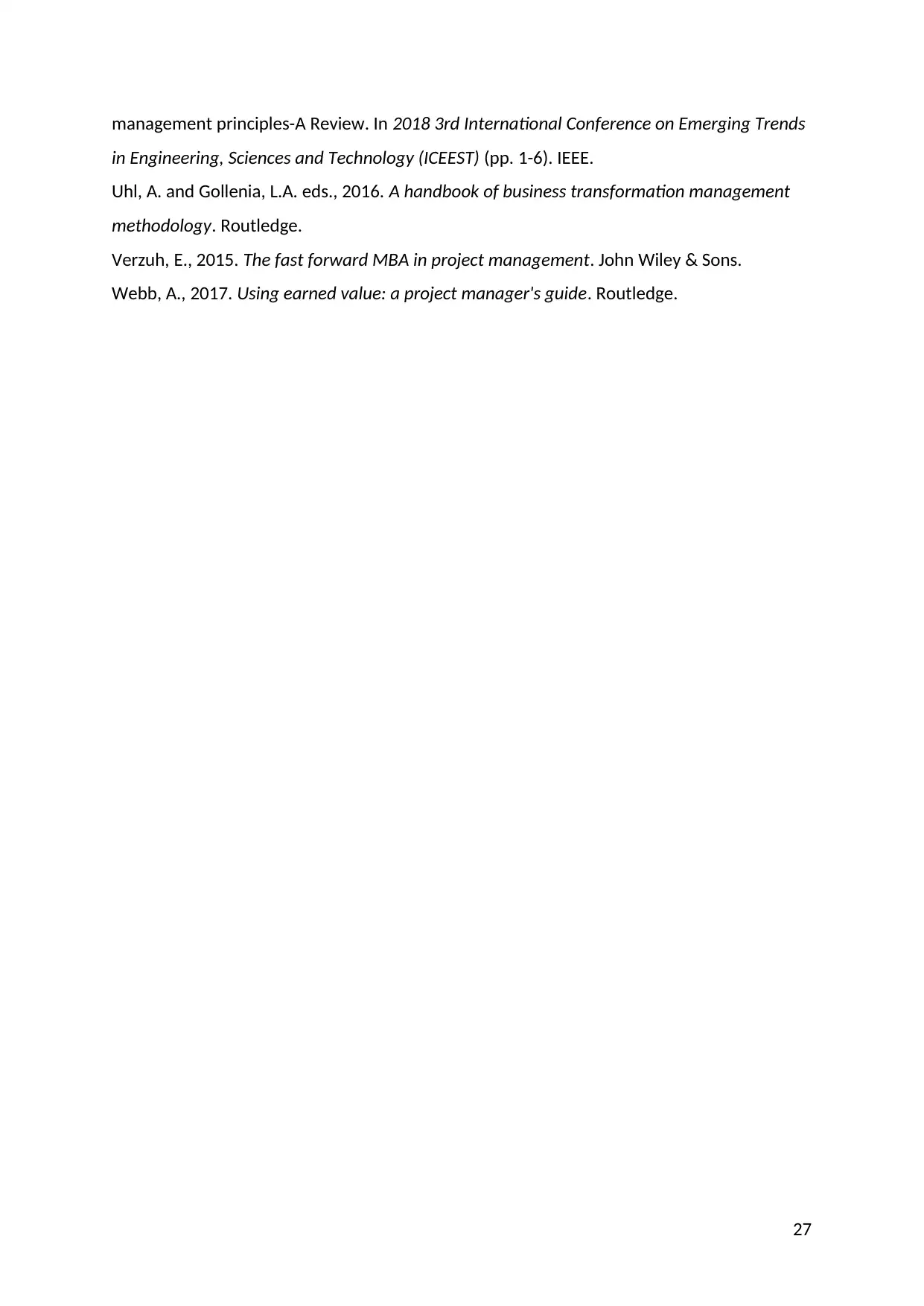
management principles-A Review. In 2018 3rd International Conference on Emerging Trends
in Engineering, Sciences and Technology (ICEEST) (pp. 1-6). IEEE.
Uhl, A. and Gollenia, L.A. eds., 2016. A handbook of business transformation management
methodology. Routledge.
Verzuh, E., 2015. The fast forward MBA in project management. John Wiley & Sons.
Webb, A., 2017. Using earned value: a project manager's guide. Routledge.
27
in Engineering, Sciences and Technology (ICEEST) (pp. 1-6). IEEE.
Uhl, A. and Gollenia, L.A. eds., 2016. A handbook of business transformation management
methodology. Routledge.
Verzuh, E., 2015. The fast forward MBA in project management. John Wiley & Sons.
Webb, A., 2017. Using earned value: a project manager's guide. Routledge.
27
Secure Best Marks with AI Grader
Need help grading? Try our AI Grader for instant feedback on your assignments.
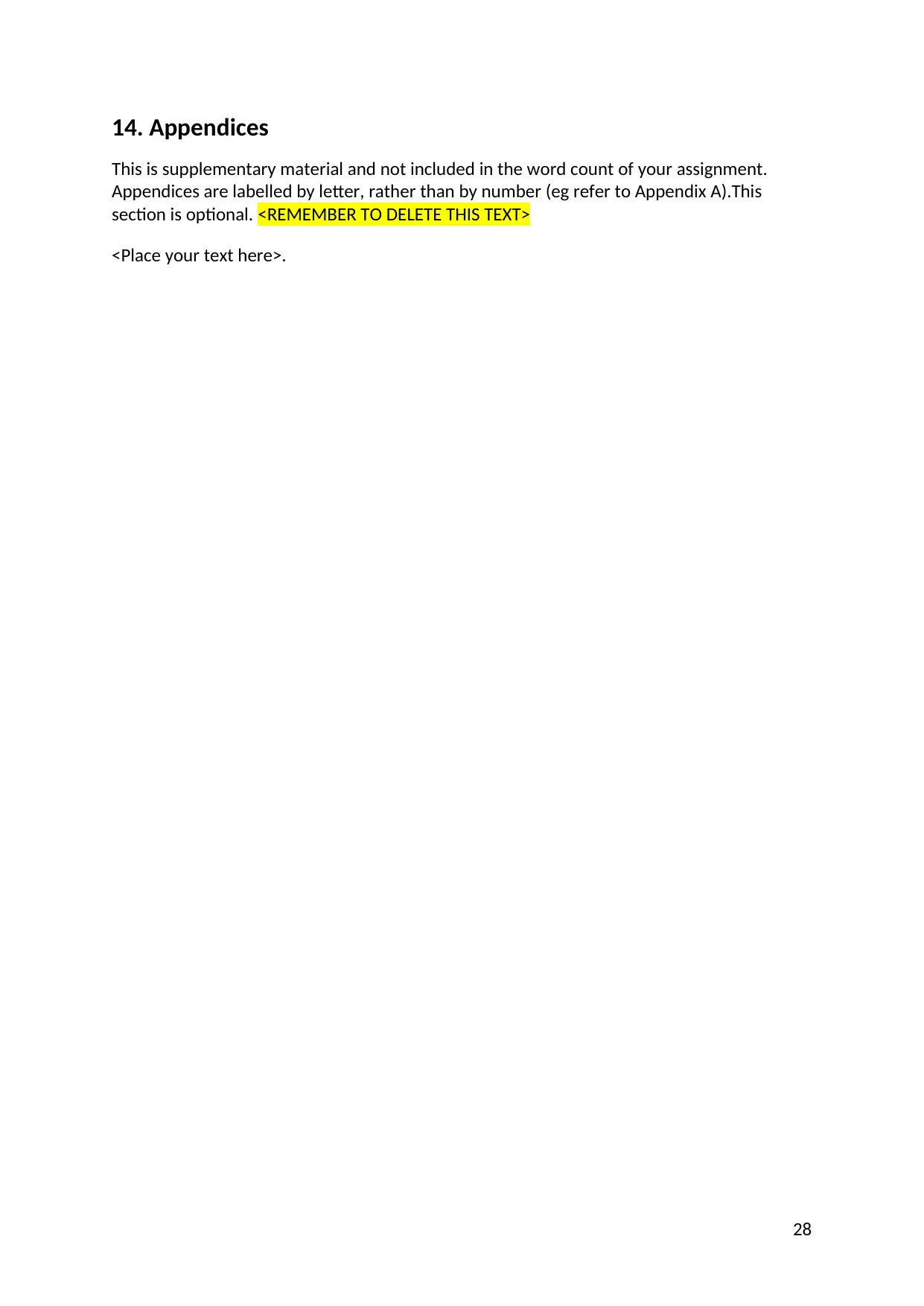
14. Appendices
This is supplementary material and not included in the word count of your assignment.
Appendices are labelled by letter, rather than by number (eg refer to Appendix A).This
section is optional. <REMEMBER TO DELETE THIS TEXT>
<Place your text here>.
28
This is supplementary material and not included in the word count of your assignment.
Appendices are labelled by letter, rather than by number (eg refer to Appendix A).This
section is optional. <REMEMBER TO DELETE THIS TEXT>
<Place your text here>.
28
1 out of 29
Related Documents
Your All-in-One AI-Powered Toolkit for Academic Success.
+13062052269
info@desklib.com
Available 24*7 on WhatsApp / Email
![[object Object]](/_next/static/media/star-bottom.7253800d.svg)
Unlock your academic potential
© 2024 | Zucol Services PVT LTD | All rights reserved.





